The Electronic Journal of Information Systems Evaluation
VerifiedAdded on 2022/08/23
|26
|7370
|24
AI Summary
Contribute Materials
Your contribution can guide someone’s learning journey. Share your
documents today.
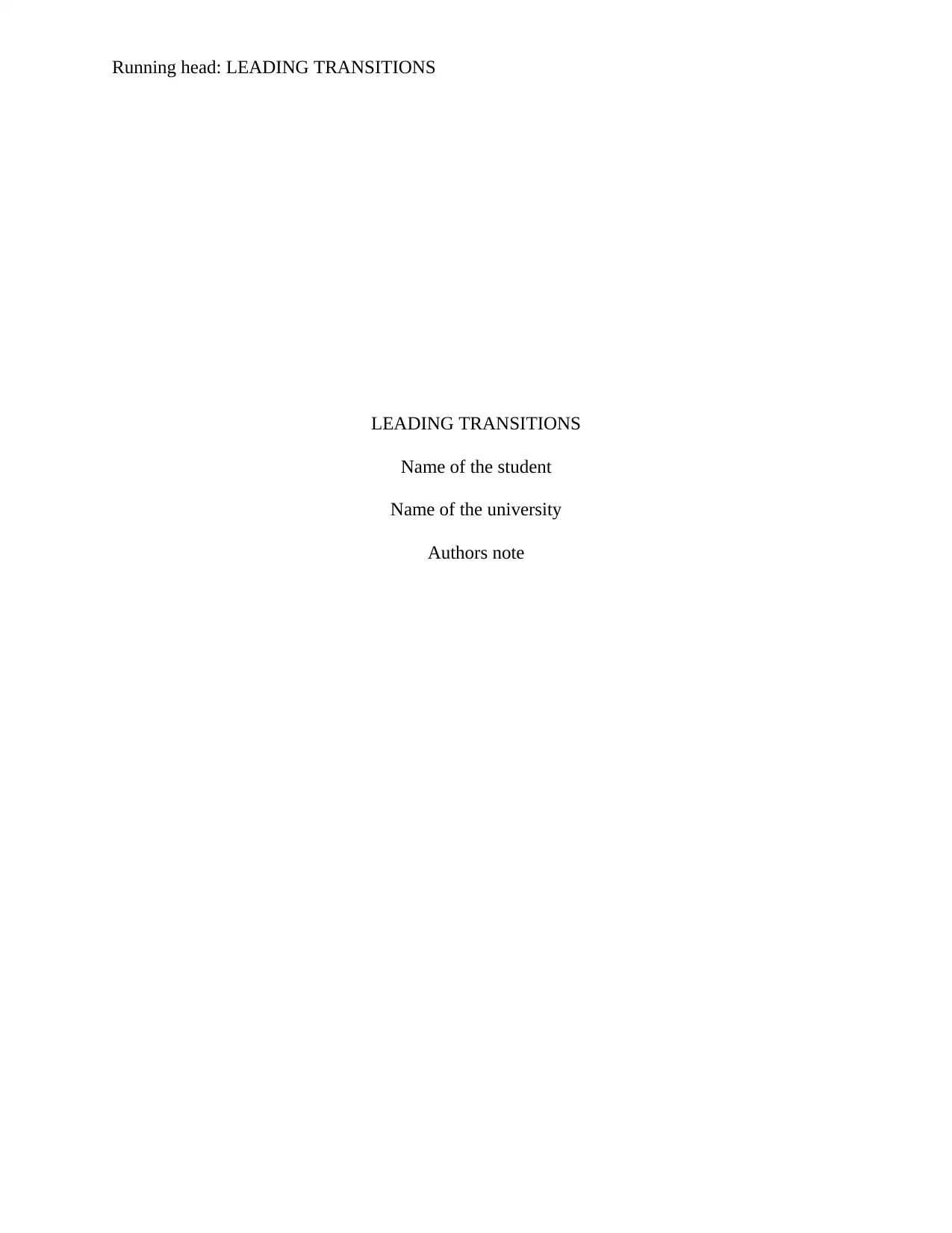
Running head: LEADING TRANSITIONS
LEADING TRANSITIONS
Name of the student
Name of the university
Authors note
LEADING TRANSITIONS
Name of the student
Name of the university
Authors note
Secure Best Marks with AI Grader
Need help grading? Try our AI Grader for instant feedback on your assignments.
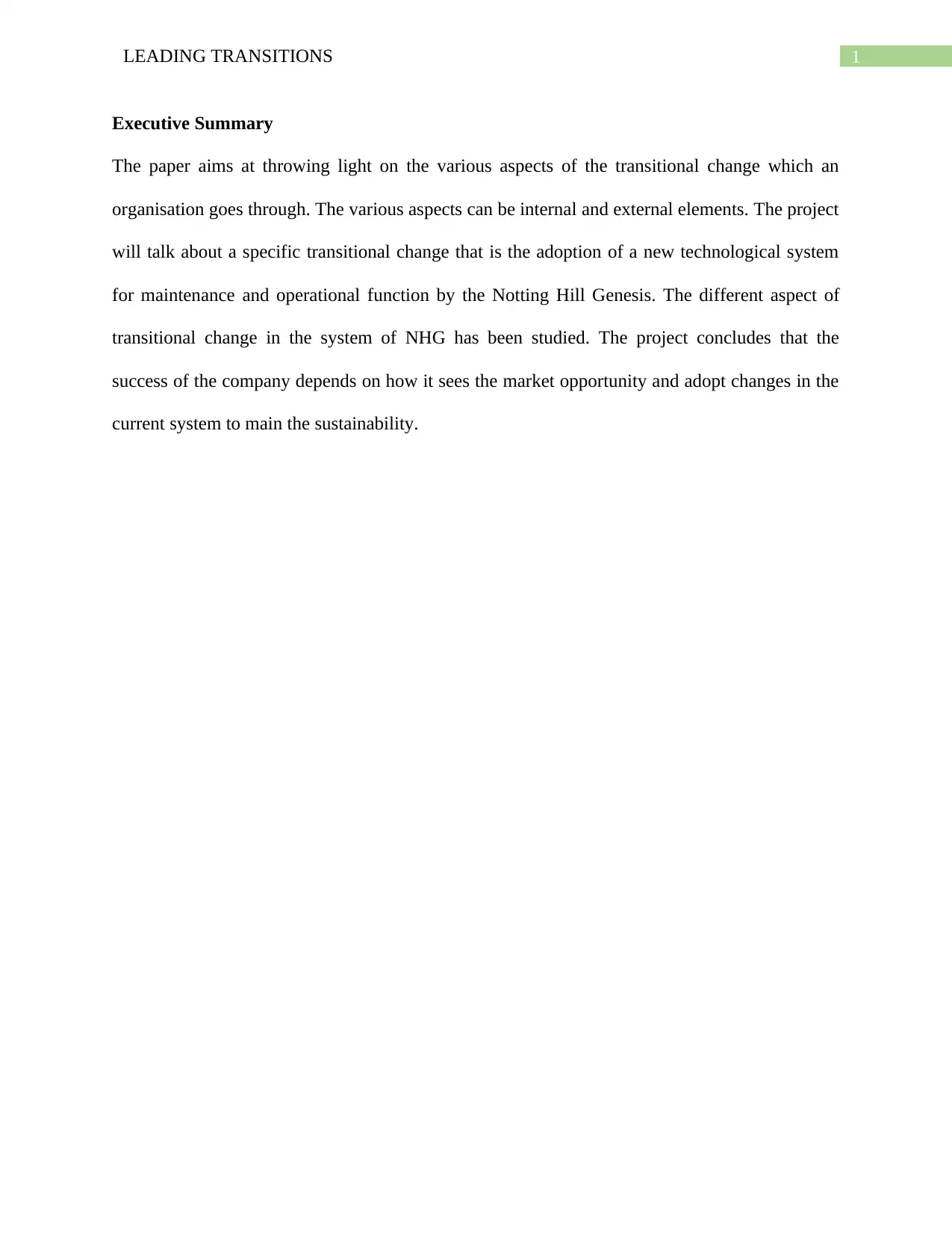
1LEADING TRANSITIONS
Executive Summary
The paper aims at throwing light on the various aspects of the transitional change which an
organisation goes through. The various aspects can be internal and external elements. The project
will talk about a specific transitional change that is the adoption of a new technological system
for maintenance and operational function by the Notting Hill Genesis. The different aspect of
transitional change in the system of NHG has been studied. The project concludes that the
success of the company depends on how it sees the market opportunity and adopt changes in the
current system to main the sustainability.
Executive Summary
The paper aims at throwing light on the various aspects of the transitional change which an
organisation goes through. The various aspects can be internal and external elements. The project
will talk about a specific transitional change that is the adoption of a new technological system
for maintenance and operational function by the Notting Hill Genesis. The different aspect of
transitional change in the system of NHG has been studied. The project concludes that the
success of the company depends on how it sees the market opportunity and adopt changes in the
current system to main the sustainability.
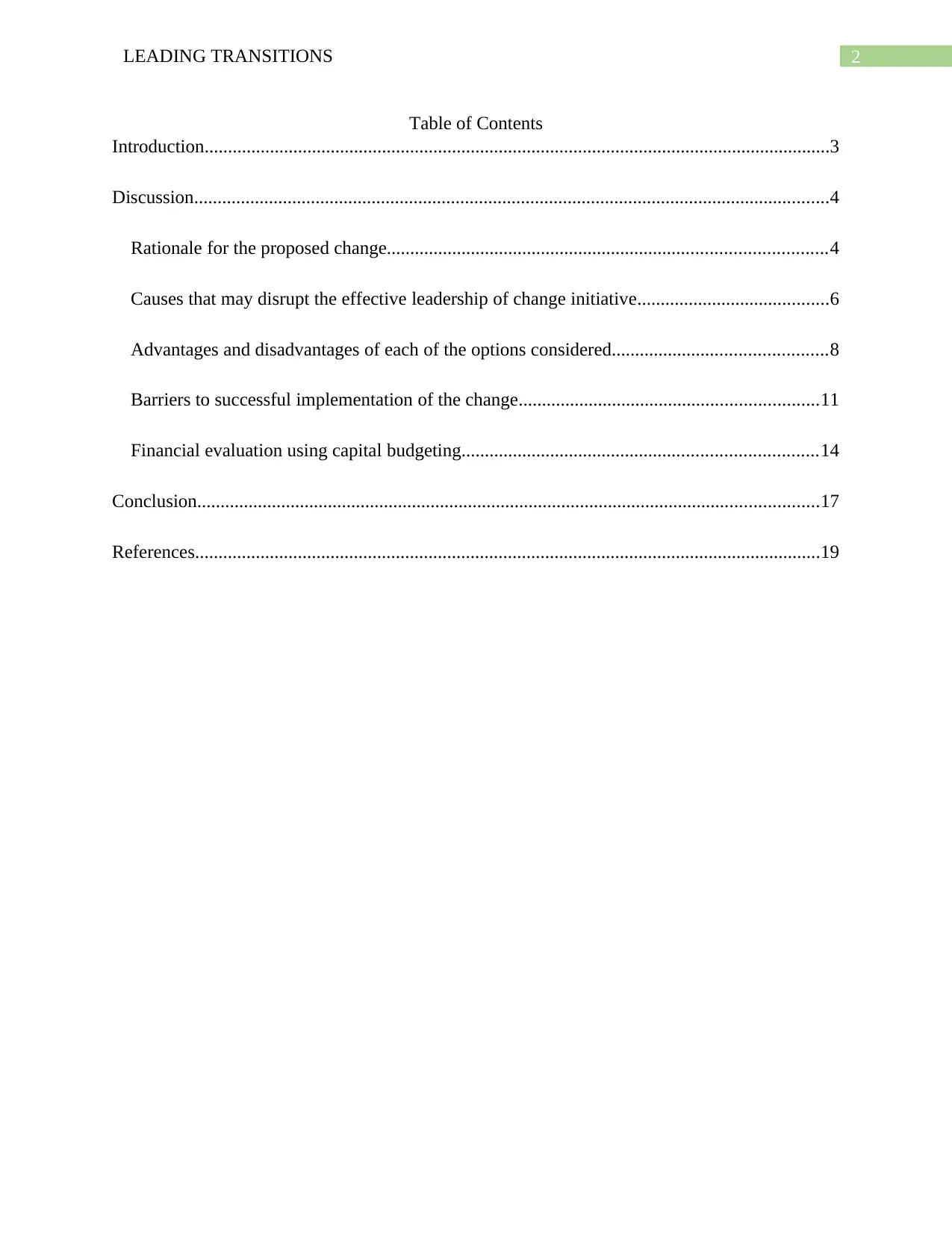
2LEADING TRANSITIONS
Table of Contents
Introduction......................................................................................................................................3
Discussion........................................................................................................................................4
Rationale for the proposed change..............................................................................................4
Causes that may disrupt the effective leadership of change initiative.........................................6
Advantages and disadvantages of each of the options considered..............................................8
Barriers to successful implementation of the change................................................................11
Financial evaluation using capital budgeting............................................................................14
Conclusion.....................................................................................................................................17
References......................................................................................................................................19
Table of Contents
Introduction......................................................................................................................................3
Discussion........................................................................................................................................4
Rationale for the proposed change..............................................................................................4
Causes that may disrupt the effective leadership of change initiative.........................................6
Advantages and disadvantages of each of the options considered..............................................8
Barriers to successful implementation of the change................................................................11
Financial evaluation using capital budgeting............................................................................14
Conclusion.....................................................................................................................................17
References......................................................................................................................................19
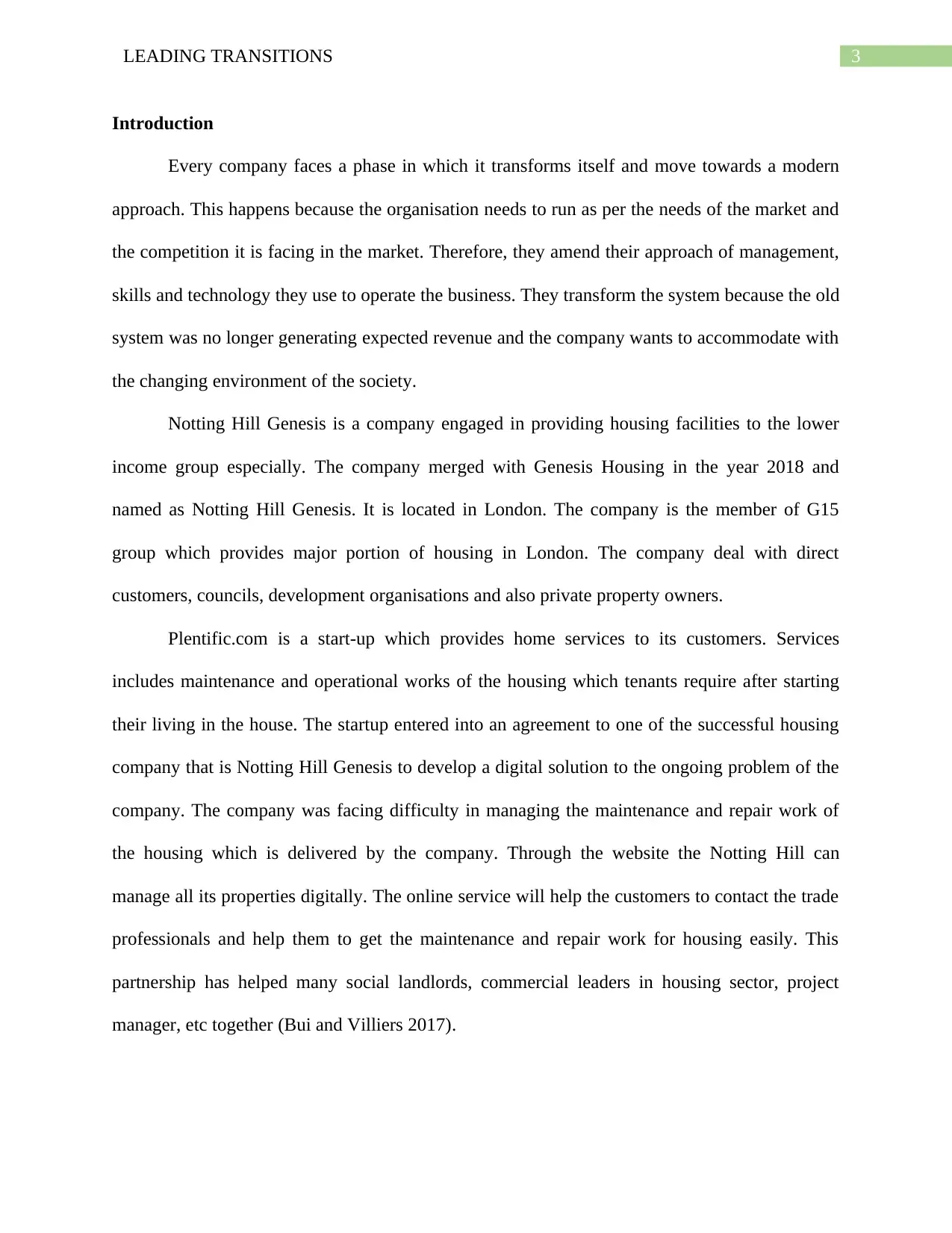
3LEADING TRANSITIONS
Introduction
Every company faces a phase in which it transforms itself and move towards a modern
approach. This happens because the organisation needs to run as per the needs of the market and
the competition it is facing in the market. Therefore, they amend their approach of management,
skills and technology they use to operate the business. They transform the system because the old
system was no longer generating expected revenue and the company wants to accommodate with
the changing environment of the society.
Notting Hill Genesis is a company engaged in providing housing facilities to the lower
income group especially. The company merged with Genesis Housing in the year 2018 and
named as Notting Hill Genesis. It is located in London. The company is the member of G15
group which provides major portion of housing in London. The company deal with direct
customers, councils, development organisations and also private property owners.
Plentific.com is a start-up which provides home services to its customers. Services
includes maintenance and operational works of the housing which tenants require after starting
their living in the house. The startup entered into an agreement to one of the successful housing
company that is Notting Hill Genesis to develop a digital solution to the ongoing problem of the
company. The company was facing difficulty in managing the maintenance and repair work of
the housing which is delivered by the company. Through the website the Notting Hill can
manage all its properties digitally. The online service will help the customers to contact the trade
professionals and help them to get the maintenance and repair work for housing easily. This
partnership has helped many social landlords, commercial leaders in housing sector, project
manager, etc together (Bui and Villiers 2017).
Introduction
Every company faces a phase in which it transforms itself and move towards a modern
approach. This happens because the organisation needs to run as per the needs of the market and
the competition it is facing in the market. Therefore, they amend their approach of management,
skills and technology they use to operate the business. They transform the system because the old
system was no longer generating expected revenue and the company wants to accommodate with
the changing environment of the society.
Notting Hill Genesis is a company engaged in providing housing facilities to the lower
income group especially. The company merged with Genesis Housing in the year 2018 and
named as Notting Hill Genesis. It is located in London. The company is the member of G15
group which provides major portion of housing in London. The company deal with direct
customers, councils, development organisations and also private property owners.
Plentific.com is a start-up which provides home services to its customers. Services
includes maintenance and operational works of the housing which tenants require after starting
their living in the house. The startup entered into an agreement to one of the successful housing
company that is Notting Hill Genesis to develop a digital solution to the ongoing problem of the
company. The company was facing difficulty in managing the maintenance and repair work of
the housing which is delivered by the company. Through the website the Notting Hill can
manage all its properties digitally. The online service will help the customers to contact the trade
professionals and help them to get the maintenance and repair work for housing easily. This
partnership has helped many social landlords, commercial leaders in housing sector, project
manager, etc together (Bui and Villiers 2017).
Secure Best Marks with AI Grader
Need help grading? Try our AI Grader for instant feedback on your assignments.
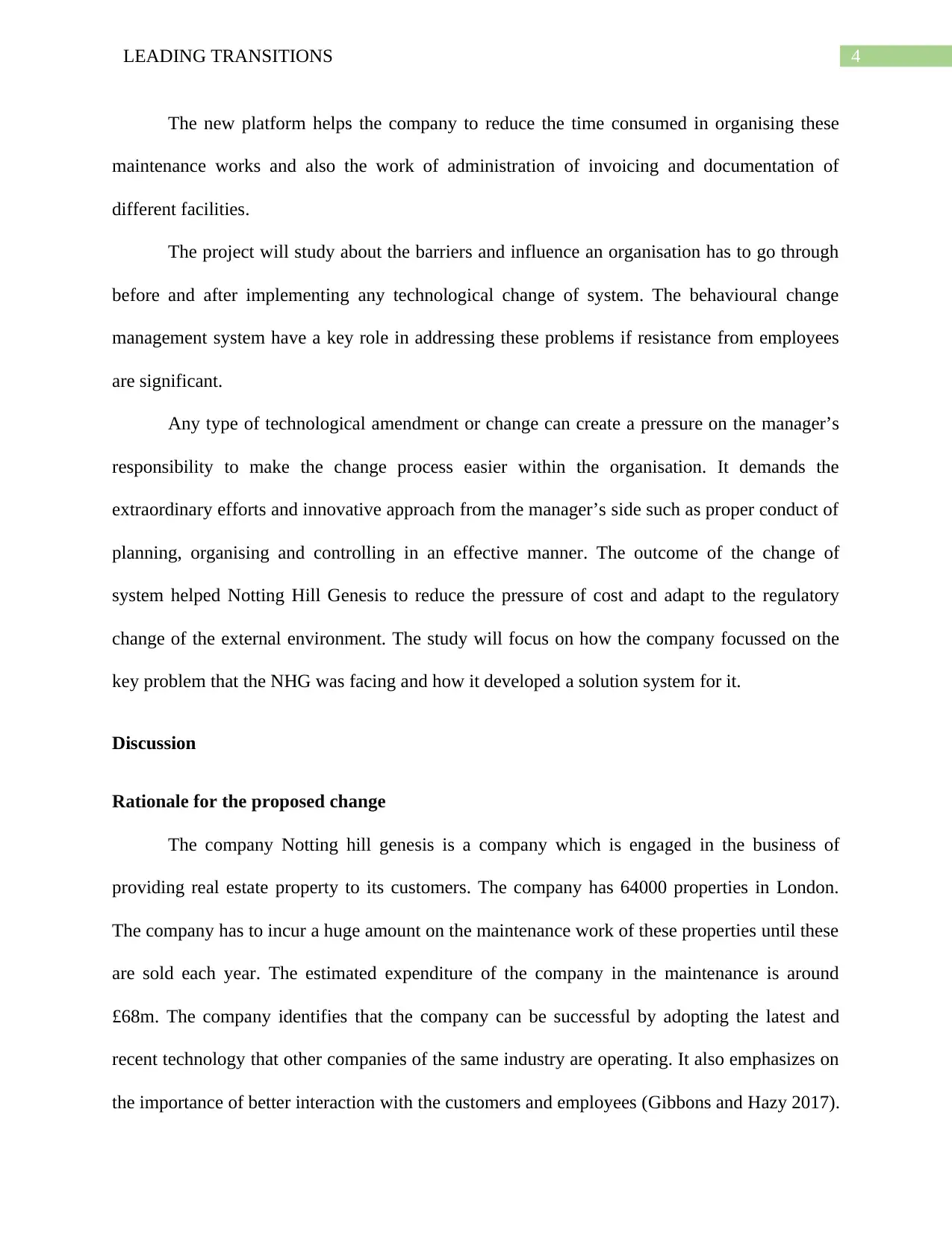
4LEADING TRANSITIONS
The new platform helps the company to reduce the time consumed in organising these
maintenance works and also the work of administration of invoicing and documentation of
different facilities.
The project will study about the barriers and influence an organisation has to go through
before and after implementing any technological change of system. The behavioural change
management system have a key role in addressing these problems if resistance from employees
are significant.
Any type of technological amendment or change can create a pressure on the manager’s
responsibility to make the change process easier within the organisation. It demands the
extraordinary efforts and innovative approach from the manager’s side such as proper conduct of
planning, organising and controlling in an effective manner. The outcome of the change of
system helped Notting Hill Genesis to reduce the pressure of cost and adapt to the regulatory
change of the external environment. The study will focus on how the company focussed on the
key problem that the NHG was facing and how it developed a solution system for it.
Discussion
Rationale for the proposed change
The company Notting hill genesis is a company which is engaged in the business of
providing real estate property to its customers. The company has 64000 properties in London.
The company has to incur a huge amount on the maintenance work of these properties until these
are sold each year. The estimated expenditure of the company in the maintenance is around
£68m. The company identifies that the company can be successful by adopting the latest and
recent technology that other companies of the same industry are operating. It also emphasizes on
the importance of better interaction with the customers and employees (Gibbons and Hazy 2017).
The new platform helps the company to reduce the time consumed in organising these
maintenance works and also the work of administration of invoicing and documentation of
different facilities.
The project will study about the barriers and influence an organisation has to go through
before and after implementing any technological change of system. The behavioural change
management system have a key role in addressing these problems if resistance from employees
are significant.
Any type of technological amendment or change can create a pressure on the manager’s
responsibility to make the change process easier within the organisation. It demands the
extraordinary efforts and innovative approach from the manager’s side such as proper conduct of
planning, organising and controlling in an effective manner. The outcome of the change of
system helped Notting Hill Genesis to reduce the pressure of cost and adapt to the regulatory
change of the external environment. The study will focus on how the company focussed on the
key problem that the NHG was facing and how it developed a solution system for it.
Discussion
Rationale for the proposed change
The company Notting hill genesis is a company which is engaged in the business of
providing real estate property to its customers. The company has 64000 properties in London.
The company has to incur a huge amount on the maintenance work of these properties until these
are sold each year. The estimated expenditure of the company in the maintenance is around
£68m. The company identifies that the company can be successful by adopting the latest and
recent technology that other companies of the same industry are operating. It also emphasizes on
the importance of better interaction with the customers and employees (Gibbons and Hazy 2017).
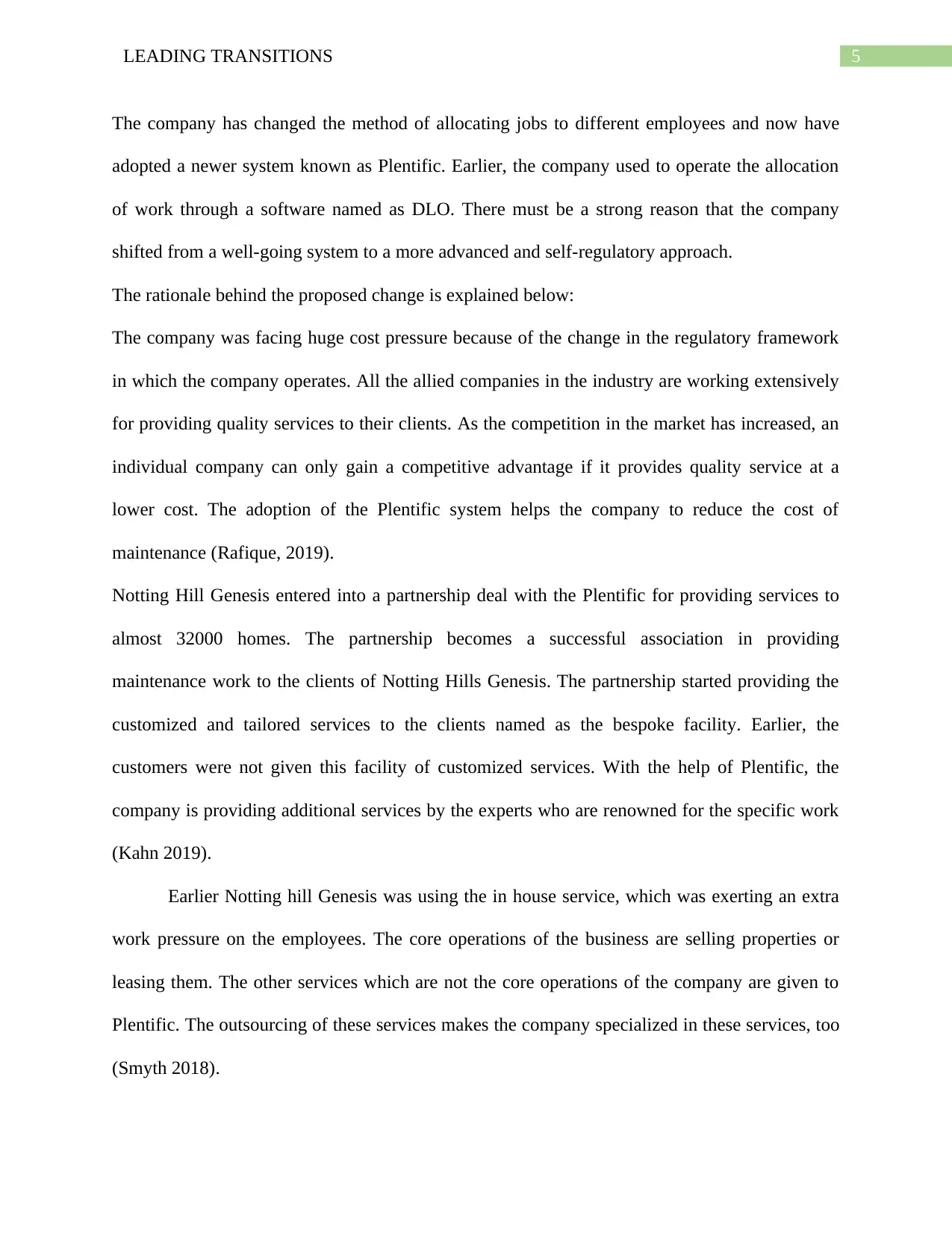
5LEADING TRANSITIONS
The company has changed the method of allocating jobs to different employees and now have
adopted a newer system known as Plentific. Earlier, the company used to operate the allocation
of work through a software named as DLO. There must be a strong reason that the company
shifted from a well-going system to a more advanced and self-regulatory approach.
The rationale behind the proposed change is explained below:
The company was facing huge cost pressure because of the change in the regulatory framework
in which the company operates. All the allied companies in the industry are working extensively
for providing quality services to their clients. As the competition in the market has increased, an
individual company can only gain a competitive advantage if it provides quality service at a
lower cost. The adoption of the Plentific system helps the company to reduce the cost of
maintenance (Rafique, 2019).
Notting Hill Genesis entered into a partnership deal with the Plentific for providing services to
almost 32000 homes. The partnership becomes a successful association in providing
maintenance work to the clients of Notting Hills Genesis. The partnership started providing the
customized and tailored services to the clients named as the bespoke facility. Earlier, the
customers were not given this facility of customized services. With the help of Plentific, the
company is providing additional services by the experts who are renowned for the specific work
(Kahn 2019).
Earlier Notting hill Genesis was using the in house service, which was exerting an extra
work pressure on the employees. The core operations of the business are selling properties or
leasing them. The other services which are not the core operations of the company are given to
Plentific. The outsourcing of these services makes the company specialized in these services, too
(Smyth 2018).
The company has changed the method of allocating jobs to different employees and now have
adopted a newer system known as Plentific. Earlier, the company used to operate the allocation
of work through a software named as DLO. There must be a strong reason that the company
shifted from a well-going system to a more advanced and self-regulatory approach.
The rationale behind the proposed change is explained below:
The company was facing huge cost pressure because of the change in the regulatory framework
in which the company operates. All the allied companies in the industry are working extensively
for providing quality services to their clients. As the competition in the market has increased, an
individual company can only gain a competitive advantage if it provides quality service at a
lower cost. The adoption of the Plentific system helps the company to reduce the cost of
maintenance (Rafique, 2019).
Notting Hill Genesis entered into a partnership deal with the Plentific for providing services to
almost 32000 homes. The partnership becomes a successful association in providing
maintenance work to the clients of Notting Hills Genesis. The partnership started providing the
customized and tailored services to the clients named as the bespoke facility. Earlier, the
customers were not given this facility of customized services. With the help of Plentific, the
company is providing additional services by the experts who are renowned for the specific work
(Kahn 2019).
Earlier Notting hill Genesis was using the in house service, which was exerting an extra
work pressure on the employees. The core operations of the business are selling properties or
leasing them. The other services which are not the core operations of the company are given to
Plentific. The outsourcing of these services makes the company specialized in these services, too
(Smyth 2018).
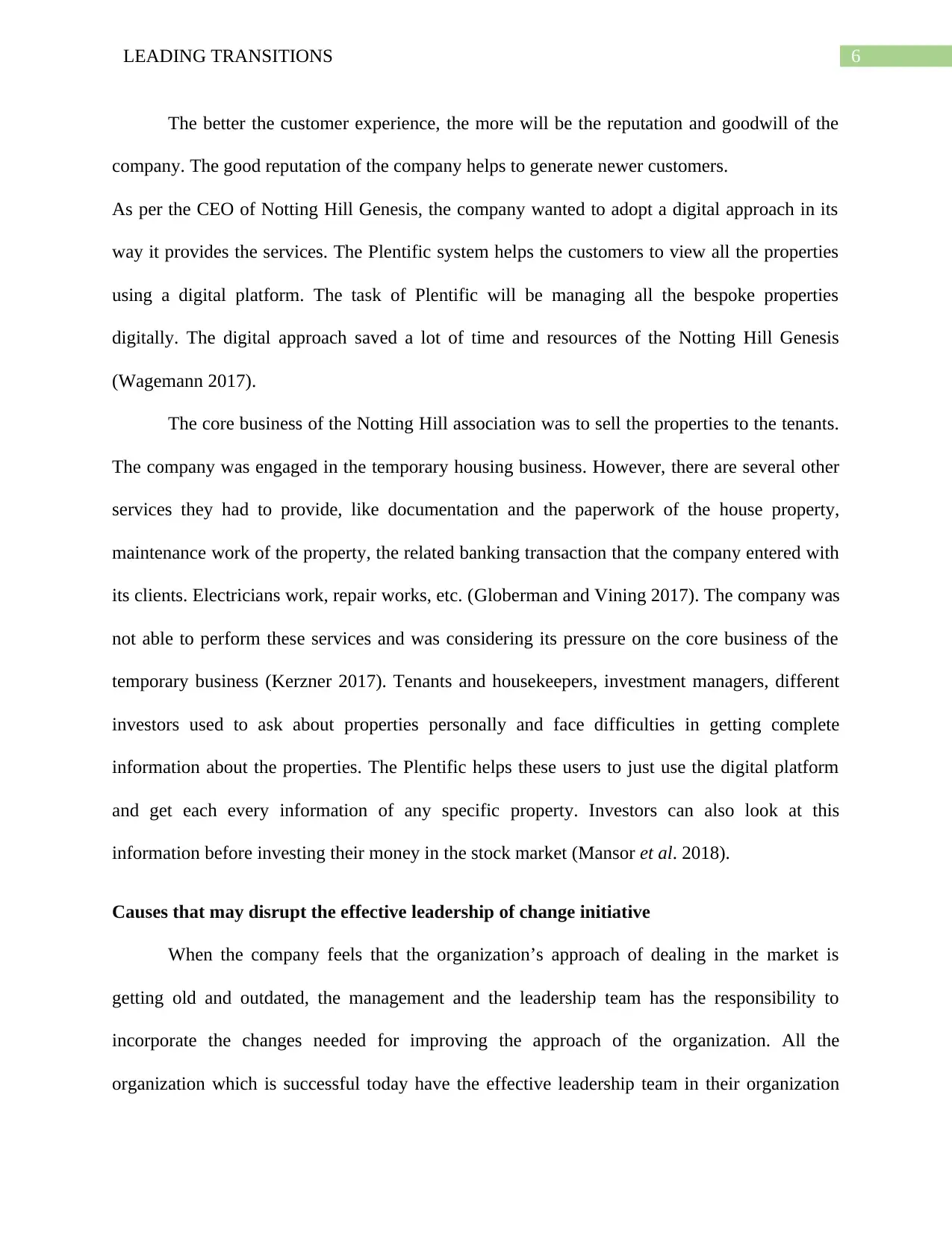
6LEADING TRANSITIONS
The better the customer experience, the more will be the reputation and goodwill of the
company. The good reputation of the company helps to generate newer customers.
As per the CEO of Notting Hill Genesis, the company wanted to adopt a digital approach in its
way it provides the services. The Plentific system helps the customers to view all the properties
using a digital platform. The task of Plentific will be managing all the bespoke properties
digitally. The digital approach saved a lot of time and resources of the Notting Hill Genesis
(Wagemann 2017).
The core business of the Notting Hill association was to sell the properties to the tenants.
The company was engaged in the temporary housing business. However, there are several other
services they had to provide, like documentation and the paperwork of the house property,
maintenance work of the property, the related banking transaction that the company entered with
its clients. Electricians work, repair works, etc. (Globerman and Vining 2017). The company was
not able to perform these services and was considering its pressure on the core business of the
temporary business (Kerzner 2017). Tenants and housekeepers, investment managers, different
investors used to ask about properties personally and face difficulties in getting complete
information about the properties. The Plentific helps these users to just use the digital platform
and get each every information of any specific property. Investors can also look at this
information before investing their money in the stock market (Mansor et al. 2018).
Causes that may disrupt the effective leadership of change initiative
When the company feels that the organization’s approach of dealing in the market is
getting old and outdated, the management and the leadership team has the responsibility to
incorporate the changes needed for improving the approach of the organization. All the
organization which is successful today have the effective leadership team in their organization
The better the customer experience, the more will be the reputation and goodwill of the
company. The good reputation of the company helps to generate newer customers.
As per the CEO of Notting Hill Genesis, the company wanted to adopt a digital approach in its
way it provides the services. The Plentific system helps the customers to view all the properties
using a digital platform. The task of Plentific will be managing all the bespoke properties
digitally. The digital approach saved a lot of time and resources of the Notting Hill Genesis
(Wagemann 2017).
The core business of the Notting Hill association was to sell the properties to the tenants.
The company was engaged in the temporary housing business. However, there are several other
services they had to provide, like documentation and the paperwork of the house property,
maintenance work of the property, the related banking transaction that the company entered with
its clients. Electricians work, repair works, etc. (Globerman and Vining 2017). The company was
not able to perform these services and was considering its pressure on the core business of the
temporary business (Kerzner 2017). Tenants and housekeepers, investment managers, different
investors used to ask about properties personally and face difficulties in getting complete
information about the properties. The Plentific helps these users to just use the digital platform
and get each every information of any specific property. Investors can also look at this
information before investing their money in the stock market (Mansor et al. 2018).
Causes that may disrupt the effective leadership of change initiative
When the company feels that the organization’s approach of dealing in the market is
getting old and outdated, the management and the leadership team has the responsibility to
incorporate the changes needed for improving the approach of the organization. All the
organization which is successful today have the effective leadership team in their organization
Paraphrase This Document
Need a fresh take? Get an instant paraphrase of this document with our AI Paraphraser
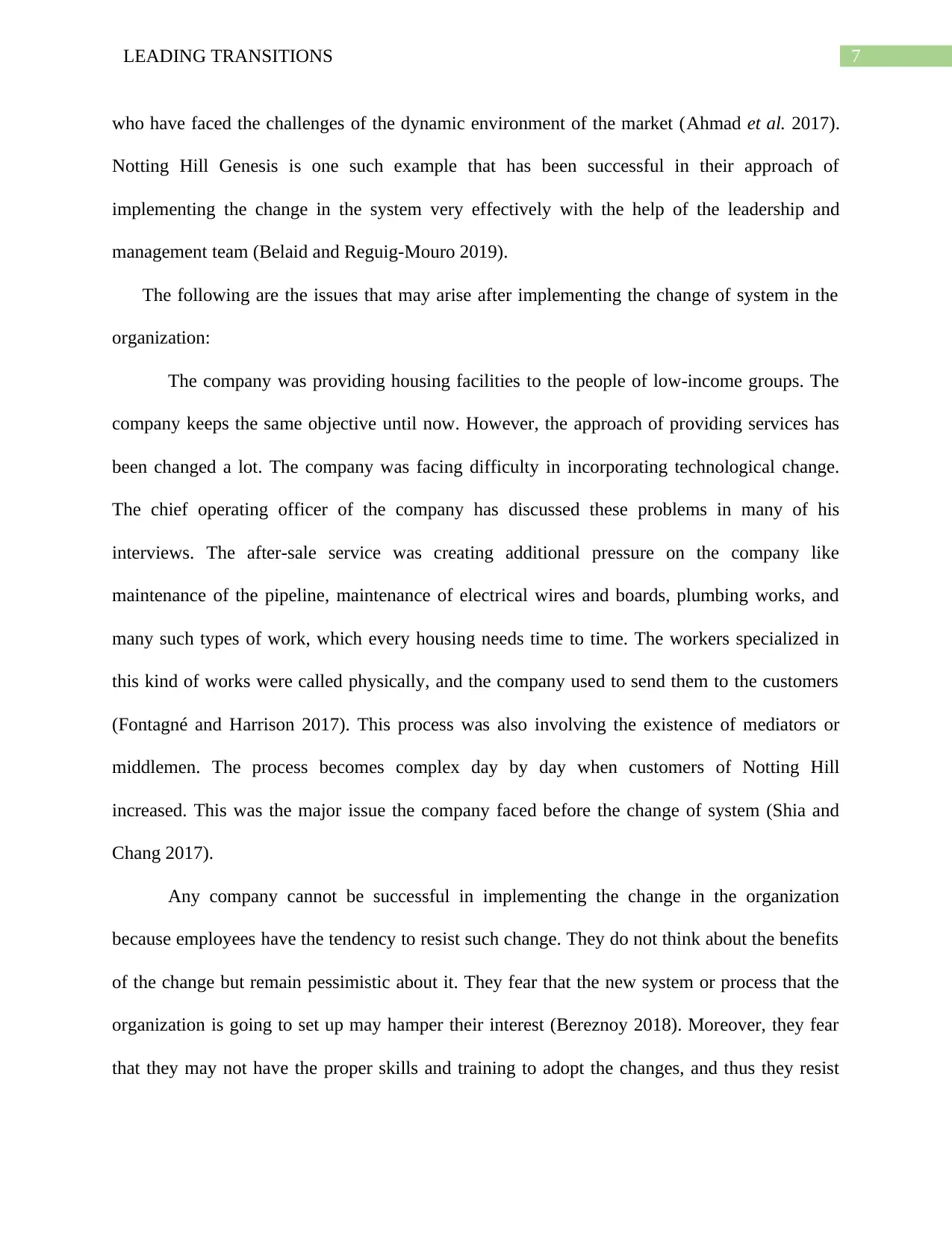
7LEADING TRANSITIONS
who have faced the challenges of the dynamic environment of the market (Ahmad et al. 2017).
Notting Hill Genesis is one such example that has been successful in their approach of
implementing the change in the system very effectively with the help of the leadership and
management team (Belaid and Reguig-Mouro 2019).
The following are the issues that may arise after implementing the change of system in the
organization:
The company was providing housing facilities to the people of low-income groups. The
company keeps the same objective until now. However, the approach of providing services has
been changed a lot. The company was facing difficulty in incorporating technological change.
The chief operating officer of the company has discussed these problems in many of his
interviews. The after-sale service was creating additional pressure on the company like
maintenance of the pipeline, maintenance of electrical wires and boards, plumbing works, and
many such types of work, which every housing needs time to time. The workers specialized in
this kind of works were called physically, and the company used to send them to the customers
(Fontagné and Harrison 2017). This process was also involving the existence of mediators or
middlemen. The process becomes complex day by day when customers of Notting Hill
increased. This was the major issue the company faced before the change of system (Shia and
Chang 2017).
Any company cannot be successful in implementing the change in the organization
because employees have the tendency to resist such change. They do not think about the benefits
of the change but remain pessimistic about it. They fear that the new system or process that the
organization is going to set up may hamper their interest (Bereznoy 2018). Moreover, they fear
that they may not have the proper skills and training to adopt the changes, and thus they resist
who have faced the challenges of the dynamic environment of the market (Ahmad et al. 2017).
Notting Hill Genesis is one such example that has been successful in their approach of
implementing the change in the system very effectively with the help of the leadership and
management team (Belaid and Reguig-Mouro 2019).
The following are the issues that may arise after implementing the change of system in the
organization:
The company was providing housing facilities to the people of low-income groups. The
company keeps the same objective until now. However, the approach of providing services has
been changed a lot. The company was facing difficulty in incorporating technological change.
The chief operating officer of the company has discussed these problems in many of his
interviews. The after-sale service was creating additional pressure on the company like
maintenance of the pipeline, maintenance of electrical wires and boards, plumbing works, and
many such types of work, which every housing needs time to time. The workers specialized in
this kind of works were called physically, and the company used to send them to the customers
(Fontagné and Harrison 2017). This process was also involving the existence of mediators or
middlemen. The process becomes complex day by day when customers of Notting Hill
increased. This was the major issue the company faced before the change of system (Shia and
Chang 2017).
Any company cannot be successful in implementing the change in the organization
because employees have the tendency to resist such change. They do not think about the benefits
of the change but remain pessimistic about it. They fear that the new system or process that the
organization is going to set up may hamper their interest (Bereznoy 2018). Moreover, they fear
that they may not have the proper skills and training to adopt the changes, and thus they resist
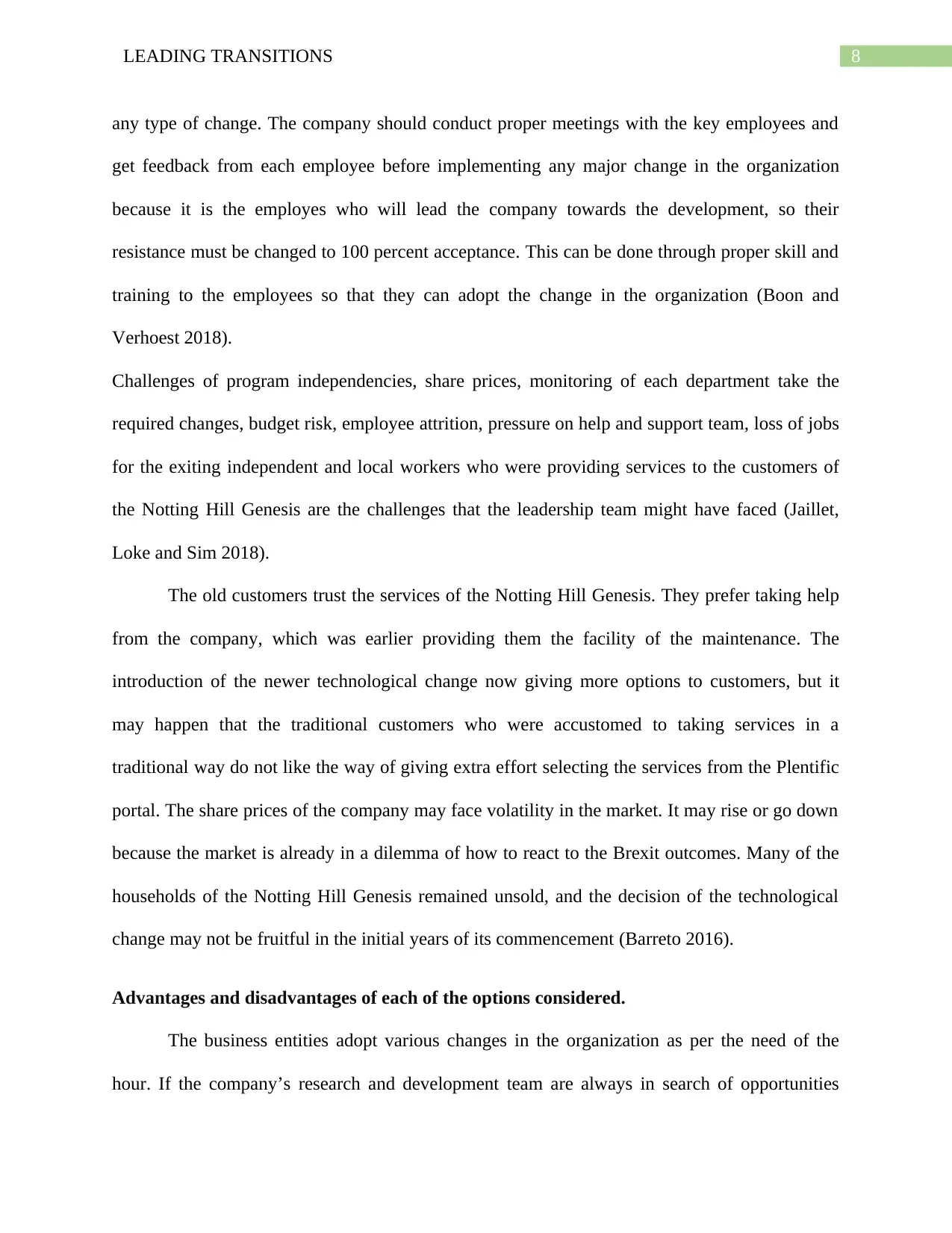
8LEADING TRANSITIONS
any type of change. The company should conduct proper meetings with the key employees and
get feedback from each employee before implementing any major change in the organization
because it is the employes who will lead the company towards the development, so their
resistance must be changed to 100 percent acceptance. This can be done through proper skill and
training to the employees so that they can adopt the change in the organization (Boon and
Verhoest 2018).
Challenges of program independencies, share prices, monitoring of each department take the
required changes, budget risk, employee attrition, pressure on help and support team, loss of jobs
for the exiting independent and local workers who were providing services to the customers of
the Notting Hill Genesis are the challenges that the leadership team might have faced (Jaillet,
Loke and Sim 2018).
The old customers trust the services of the Notting Hill Genesis. They prefer taking help
from the company, which was earlier providing them the facility of the maintenance. The
introduction of the newer technological change now giving more options to customers, but it
may happen that the traditional customers who were accustomed to taking services in a
traditional way do not like the way of giving extra effort selecting the services from the Plentific
portal. The share prices of the company may face volatility in the market. It may rise or go down
because the market is already in a dilemma of how to react to the Brexit outcomes. Many of the
households of the Notting Hill Genesis remained unsold, and the decision of the technological
change may not be fruitful in the initial years of its commencement (Barreto 2016).
Advantages and disadvantages of each of the options considered.
The business entities adopt various changes in the organization as per the need of the
hour. If the company’s research and development team are always in search of opportunities
any type of change. The company should conduct proper meetings with the key employees and
get feedback from each employee before implementing any major change in the organization
because it is the employes who will lead the company towards the development, so their
resistance must be changed to 100 percent acceptance. This can be done through proper skill and
training to the employees so that they can adopt the change in the organization (Boon and
Verhoest 2018).
Challenges of program independencies, share prices, monitoring of each department take the
required changes, budget risk, employee attrition, pressure on help and support team, loss of jobs
for the exiting independent and local workers who were providing services to the customers of
the Notting Hill Genesis are the challenges that the leadership team might have faced (Jaillet,
Loke and Sim 2018).
The old customers trust the services of the Notting Hill Genesis. They prefer taking help
from the company, which was earlier providing them the facility of the maintenance. The
introduction of the newer technological change now giving more options to customers, but it
may happen that the traditional customers who were accustomed to taking services in a
traditional way do not like the way of giving extra effort selecting the services from the Plentific
portal. The share prices of the company may face volatility in the market. It may rise or go down
because the market is already in a dilemma of how to react to the Brexit outcomes. Many of the
households of the Notting Hill Genesis remained unsold, and the decision of the technological
change may not be fruitful in the initial years of its commencement (Barreto 2016).
Advantages and disadvantages of each of the options considered.
The business entities adopt various changes in the organization as per the need of the
hour. If the company’s research and development team are always in search of opportunities
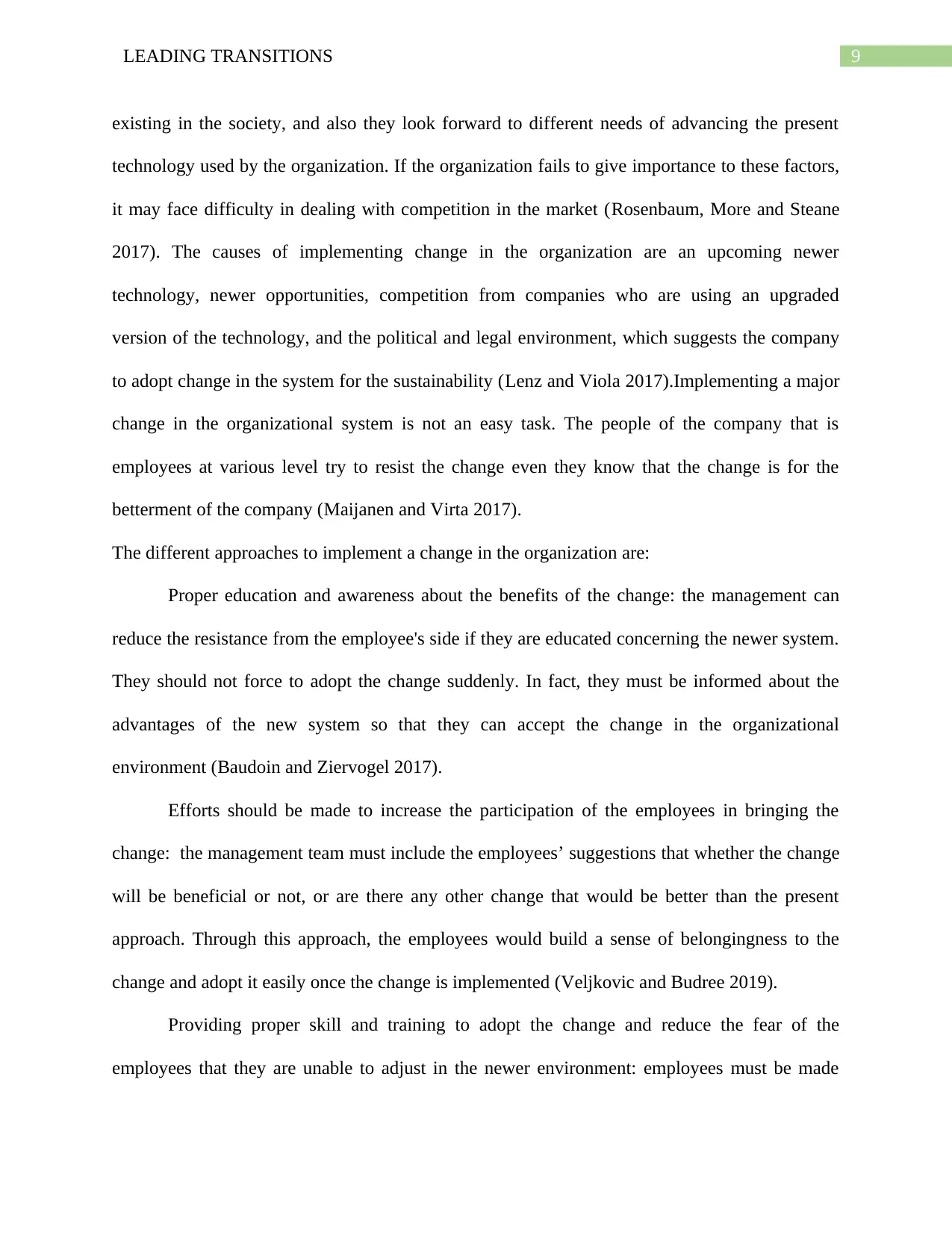
9LEADING TRANSITIONS
existing in the society, and also they look forward to different needs of advancing the present
technology used by the organization. If the organization fails to give importance to these factors,
it may face difficulty in dealing with competition in the market (Rosenbaum, More and Steane
2017). The causes of implementing change in the organization are an upcoming newer
technology, newer opportunities, competition from companies who are using an upgraded
version of the technology, and the political and legal environment, which suggests the company
to adopt change in the system for the sustainability (Lenz and Viola 2017).Implementing a major
change in the organizational system is not an easy task. The people of the company that is
employees at various level try to resist the change even they know that the change is for the
betterment of the company (Maijanen and Virta 2017).
The different approaches to implement a change in the organization are:
Proper education and awareness about the benefits of the change: the management can
reduce the resistance from the employee's side if they are educated concerning the newer system.
They should not force to adopt the change suddenly. In fact, they must be informed about the
advantages of the new system so that they can accept the change in the organizational
environment (Baudoin and Ziervogel 2017).
Efforts should be made to increase the participation of the employees in bringing the
change: the management team must include the employees’ suggestions that whether the change
will be beneficial or not, or are there any other change that would be better than the present
approach. Through this approach, the employees would build a sense of belongingness to the
change and adopt it easily once the change is implemented (Veljkovic and Budree 2019).
Providing proper skill and training to adopt the change and reduce the fear of the
employees that they are unable to adjust in the newer environment: employees must be made
existing in the society, and also they look forward to different needs of advancing the present
technology used by the organization. If the organization fails to give importance to these factors,
it may face difficulty in dealing with competition in the market (Rosenbaum, More and Steane
2017). The causes of implementing change in the organization are an upcoming newer
technology, newer opportunities, competition from companies who are using an upgraded
version of the technology, and the political and legal environment, which suggests the company
to adopt change in the system for the sustainability (Lenz and Viola 2017).Implementing a major
change in the organizational system is not an easy task. The people of the company that is
employees at various level try to resist the change even they know that the change is for the
betterment of the company (Maijanen and Virta 2017).
The different approaches to implement a change in the organization are:
Proper education and awareness about the benefits of the change: the management can
reduce the resistance from the employee's side if they are educated concerning the newer system.
They should not force to adopt the change suddenly. In fact, they must be informed about the
advantages of the new system so that they can accept the change in the organizational
environment (Baudoin and Ziervogel 2017).
Efforts should be made to increase the participation of the employees in bringing the
change: the management team must include the employees’ suggestions that whether the change
will be beneficial or not, or are there any other change that would be better than the present
approach. Through this approach, the employees would build a sense of belongingness to the
change and adopt it easily once the change is implemented (Veljkovic and Budree 2019).
Providing proper skill and training to adopt the change and reduce the fear of the
employees that they are unable to adjust in the newer environment: employees must be made
Secure Best Marks with AI Grader
Need help grading? Try our AI Grader for instant feedback on your assignments.
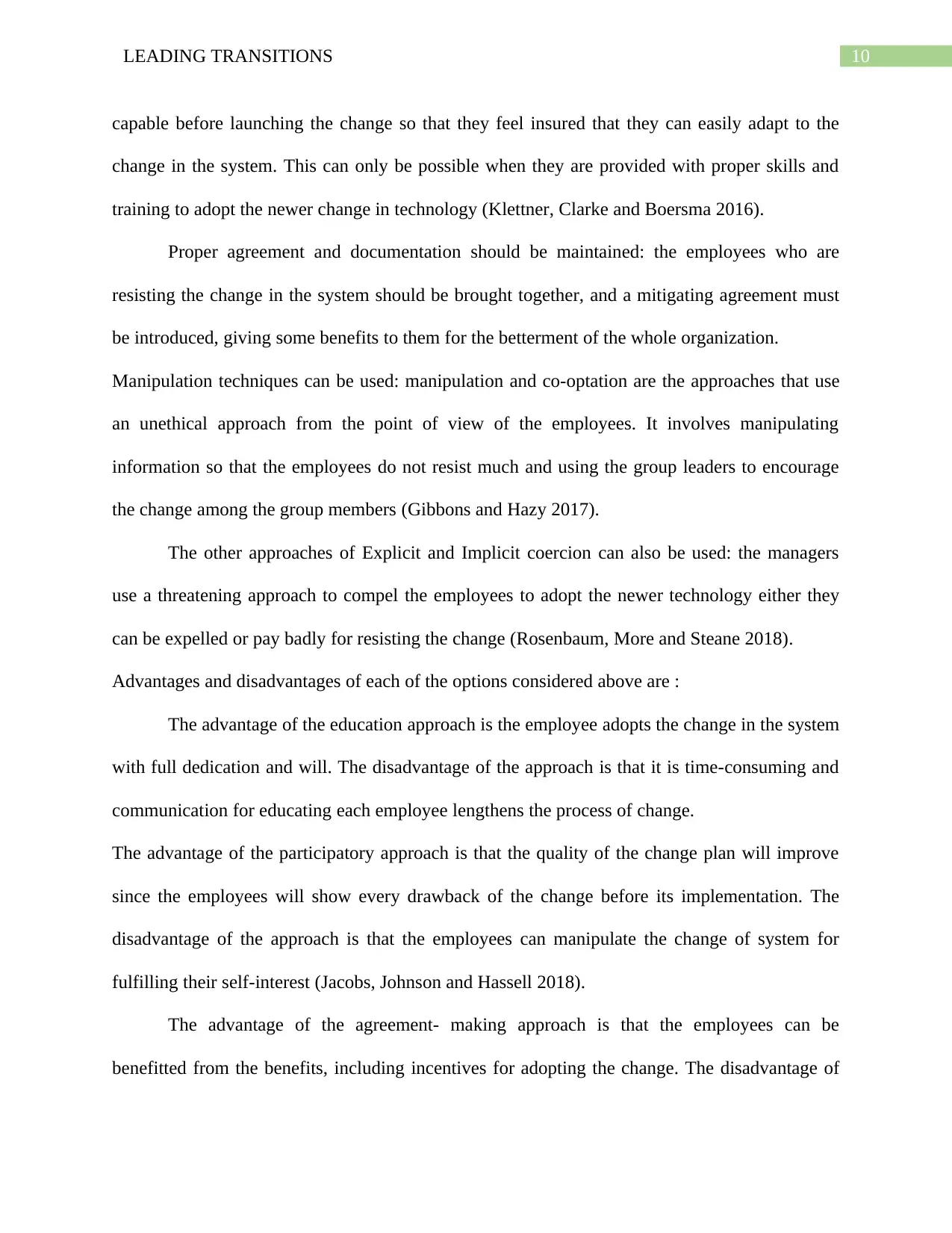
10LEADING TRANSITIONS
capable before launching the change so that they feel insured that they can easily adapt to the
change in the system. This can only be possible when they are provided with proper skills and
training to adopt the newer change in technology (Klettner, Clarke and Boersma 2016).
Proper agreement and documentation should be maintained: the employees who are
resisting the change in the system should be brought together, and a mitigating agreement must
be introduced, giving some benefits to them for the betterment of the whole organization.
Manipulation techniques can be used: manipulation and co-optation are the approaches that use
an unethical approach from the point of view of the employees. It involves manipulating
information so that the employees do not resist much and using the group leaders to encourage
the change among the group members (Gibbons and Hazy 2017).
The other approaches of Explicit and Implicit coercion can also be used: the managers
use a threatening approach to compel the employees to adopt the newer technology either they
can be expelled or pay badly for resisting the change (Rosenbaum, More and Steane 2018).
Advantages and disadvantages of each of the options considered above are :
The advantage of the education approach is the employee adopts the change in the system
with full dedication and will. The disadvantage of the approach is that it is time-consuming and
communication for educating each employee lengthens the process of change.
The advantage of the participatory approach is that the quality of the change plan will improve
since the employees will show every drawback of the change before its implementation. The
disadvantage of the approach is that the employees can manipulate the change of system for
fulfilling their self-interest (Jacobs, Johnson and Hassell 2018).
The advantage of the agreement- making approach is that the employees can be
benefitted from the benefits, including incentives for adopting the change. The disadvantage of
capable before launching the change so that they feel insured that they can easily adapt to the
change in the system. This can only be possible when they are provided with proper skills and
training to adopt the newer change in technology (Klettner, Clarke and Boersma 2016).
Proper agreement and documentation should be maintained: the employees who are
resisting the change in the system should be brought together, and a mitigating agreement must
be introduced, giving some benefits to them for the betterment of the whole organization.
Manipulation techniques can be used: manipulation and co-optation are the approaches that use
an unethical approach from the point of view of the employees. It involves manipulating
information so that the employees do not resist much and using the group leaders to encourage
the change among the group members (Gibbons and Hazy 2017).
The other approaches of Explicit and Implicit coercion can also be used: the managers
use a threatening approach to compel the employees to adopt the newer technology either they
can be expelled or pay badly for resisting the change (Rosenbaum, More and Steane 2018).
Advantages and disadvantages of each of the options considered above are :
The advantage of the education approach is the employee adopts the change in the system
with full dedication and will. The disadvantage of the approach is that it is time-consuming and
communication for educating each employee lengthens the process of change.
The advantage of the participatory approach is that the quality of the change plan will improve
since the employees will show every drawback of the change before its implementation. The
disadvantage of the approach is that the employees can manipulate the change of system for
fulfilling their self-interest (Jacobs, Johnson and Hassell 2018).
The advantage of the agreement- making approach is that the employees can be
benefitted from the benefits, including incentives for adopting the change. The disadvantage of
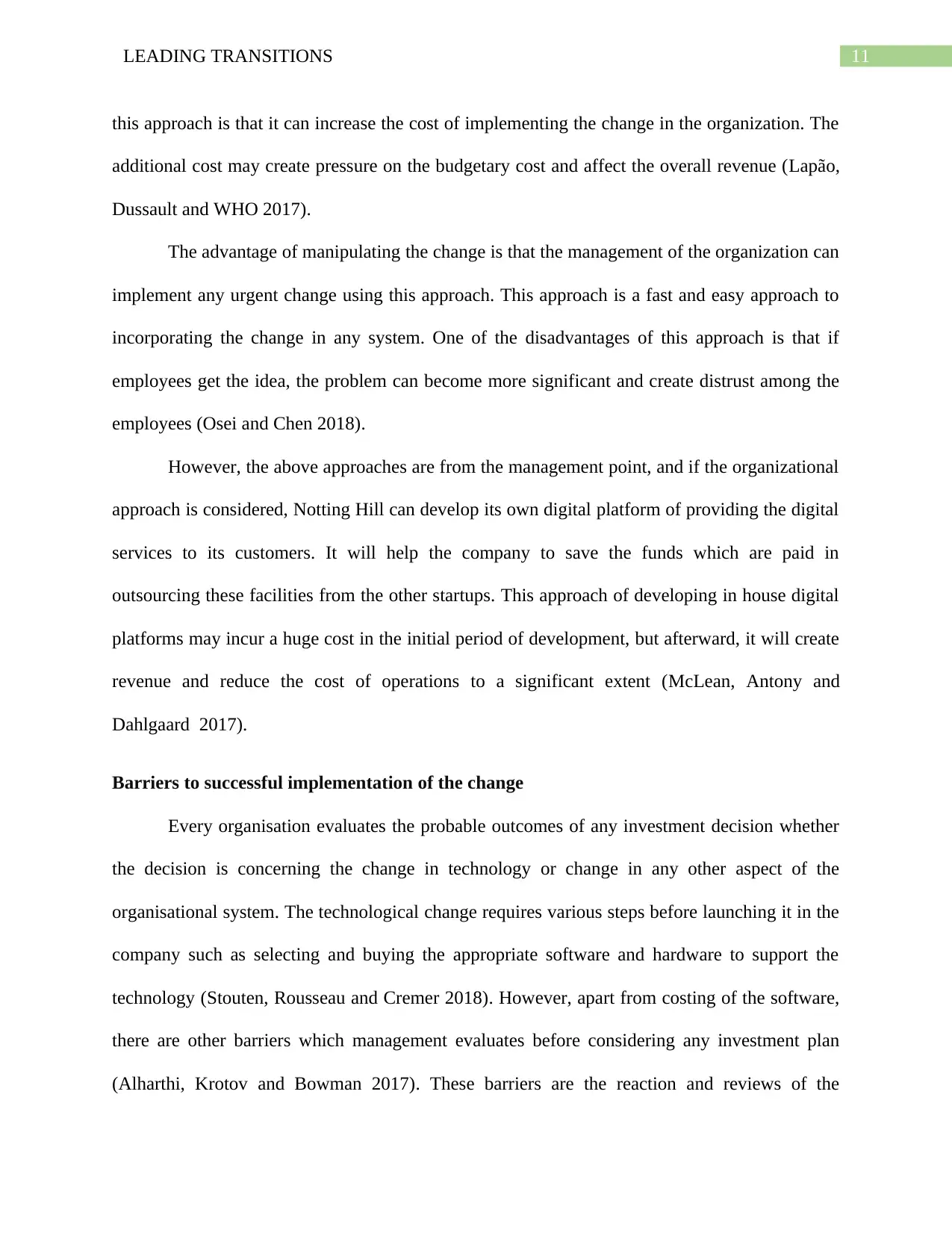
11LEADING TRANSITIONS
this approach is that it can increase the cost of implementing the change in the organization. The
additional cost may create pressure on the budgetary cost and affect the overall revenue (Lapão,
Dussault and WHO 2017).
The advantage of manipulating the change is that the management of the organization can
implement any urgent change using this approach. This approach is a fast and easy approach to
incorporating the change in any system. One of the disadvantages of this approach is that if
employees get the idea, the problem can become more significant and create distrust among the
employees (Osei and Chen 2018).
However, the above approaches are from the management point, and if the organizational
approach is considered, Notting Hill can develop its own digital platform of providing the digital
services to its customers. It will help the company to save the funds which are paid in
outsourcing these facilities from the other startups. This approach of developing in house digital
platforms may incur a huge cost in the initial period of development, but afterward, it will create
revenue and reduce the cost of operations to a significant extent (McLean, Antony and
Dahlgaard 2017).
Barriers to successful implementation of the change
Every organisation evaluates the probable outcomes of any investment decision whether
the decision is concerning the change in technology or change in any other aspect of the
organisational system. The technological change requires various steps before launching it in the
company such as selecting and buying the appropriate software and hardware to support the
technology (Stouten, Rousseau and Cremer 2018). However, apart from costing of the software,
there are other barriers which management evaluates before considering any investment plan
(Alharthi, Krotov and Bowman 2017). These barriers are the reaction and reviews of the
this approach is that it can increase the cost of implementing the change in the organization. The
additional cost may create pressure on the budgetary cost and affect the overall revenue (Lapão,
Dussault and WHO 2017).
The advantage of manipulating the change is that the management of the organization can
implement any urgent change using this approach. This approach is a fast and easy approach to
incorporating the change in any system. One of the disadvantages of this approach is that if
employees get the idea, the problem can become more significant and create distrust among the
employees (Osei and Chen 2018).
However, the above approaches are from the management point, and if the organizational
approach is considered, Notting Hill can develop its own digital platform of providing the digital
services to its customers. It will help the company to save the funds which are paid in
outsourcing these facilities from the other startups. This approach of developing in house digital
platforms may incur a huge cost in the initial period of development, but afterward, it will create
revenue and reduce the cost of operations to a significant extent (McLean, Antony and
Dahlgaard 2017).
Barriers to successful implementation of the change
Every organisation evaluates the probable outcomes of any investment decision whether
the decision is concerning the change in technology or change in any other aspect of the
organisational system. The technological change requires various steps before launching it in the
company such as selecting and buying the appropriate software and hardware to support the
technology (Stouten, Rousseau and Cremer 2018). However, apart from costing of the software,
there are other barriers which management evaluates before considering any investment plan
(Alharthi, Krotov and Bowman 2017). These barriers are the reaction and reviews of the
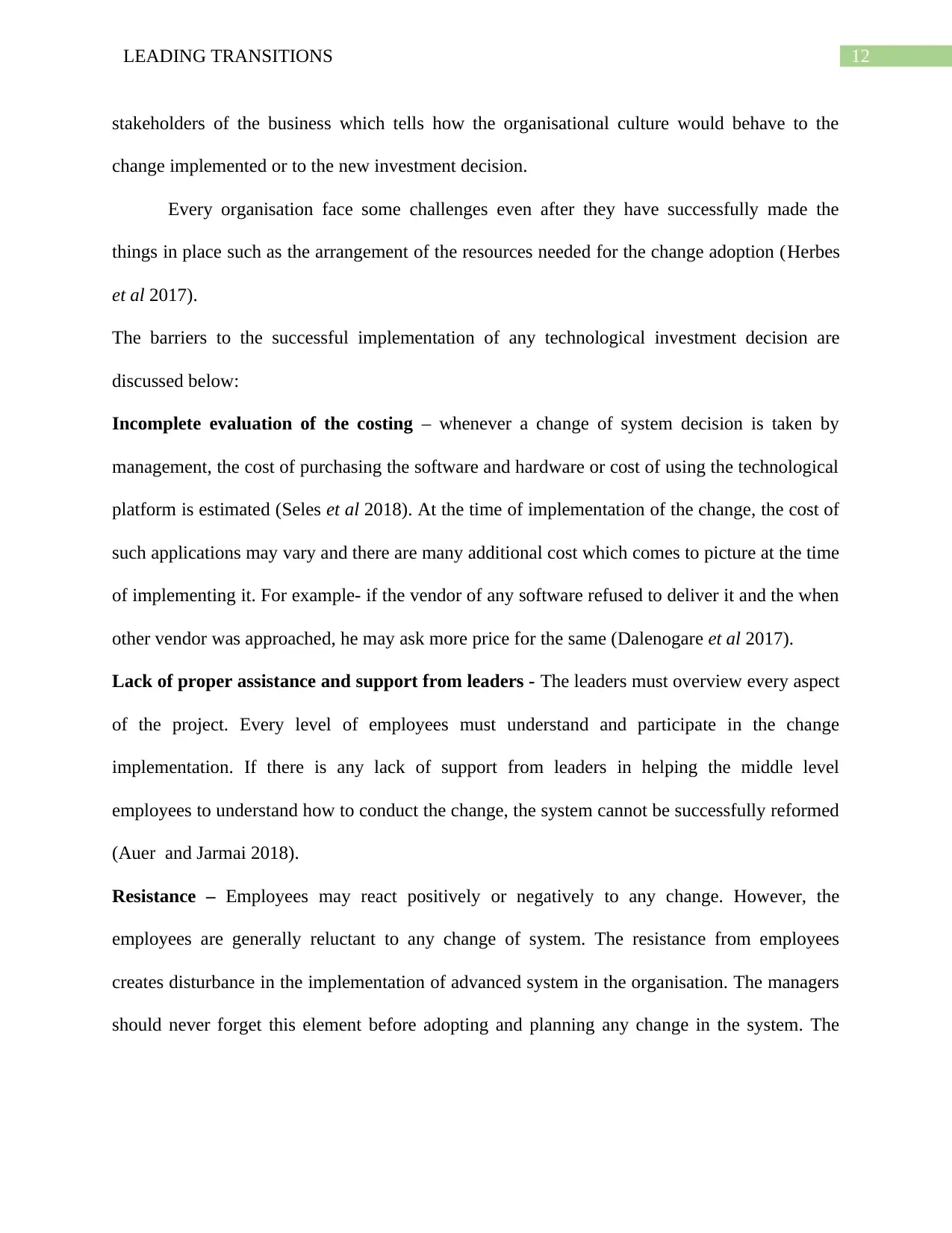
12LEADING TRANSITIONS
stakeholders of the business which tells how the organisational culture would behave to the
change implemented or to the new investment decision.
Every organisation face some challenges even after they have successfully made the
things in place such as the arrangement of the resources needed for the change adoption (Herbes
et al 2017).
The barriers to the successful implementation of any technological investment decision are
discussed below:
Incomplete evaluation of the costing – whenever a change of system decision is taken by
management, the cost of purchasing the software and hardware or cost of using the technological
platform is estimated (Seles et al 2018). At the time of implementation of the change, the cost of
such applications may vary and there are many additional cost which comes to picture at the time
of implementing it. For example- if the vendor of any software refused to deliver it and the when
other vendor was approached, he may ask more price for the same (Dalenogare et al 2017).
Lack of proper assistance and support from leaders - The leaders must overview every aspect
of the project. Every level of employees must understand and participate in the change
implementation. If there is any lack of support from leaders in helping the middle level
employees to understand how to conduct the change, the system cannot be successfully reformed
(Auer and Jarmai 2018).
Resistance – Employees may react positively or negatively to any change. However, the
employees are generally reluctant to any change of system. The resistance from employees
creates disturbance in the implementation of advanced system in the organisation. The managers
should never forget this element before adopting and planning any change in the system. The
stakeholders of the business which tells how the organisational culture would behave to the
change implemented or to the new investment decision.
Every organisation face some challenges even after they have successfully made the
things in place such as the arrangement of the resources needed for the change adoption (Herbes
et al 2017).
The barriers to the successful implementation of any technological investment decision are
discussed below:
Incomplete evaluation of the costing – whenever a change of system decision is taken by
management, the cost of purchasing the software and hardware or cost of using the technological
platform is estimated (Seles et al 2018). At the time of implementation of the change, the cost of
such applications may vary and there are many additional cost which comes to picture at the time
of implementing it. For example- if the vendor of any software refused to deliver it and the when
other vendor was approached, he may ask more price for the same (Dalenogare et al 2017).
Lack of proper assistance and support from leaders - The leaders must overview every aspect
of the project. Every level of employees must understand and participate in the change
implementation. If there is any lack of support from leaders in helping the middle level
employees to understand how to conduct the change, the system cannot be successfully reformed
(Auer and Jarmai 2018).
Resistance – Employees may react positively or negatively to any change. However, the
employees are generally reluctant to any change of system. The resistance from employees
creates disturbance in the implementation of advanced system in the organisation. The managers
should never forget this element before adopting and planning any change in the system. The
Paraphrase This Document
Need a fresh take? Get an instant paraphrase of this document with our AI Paraphraser
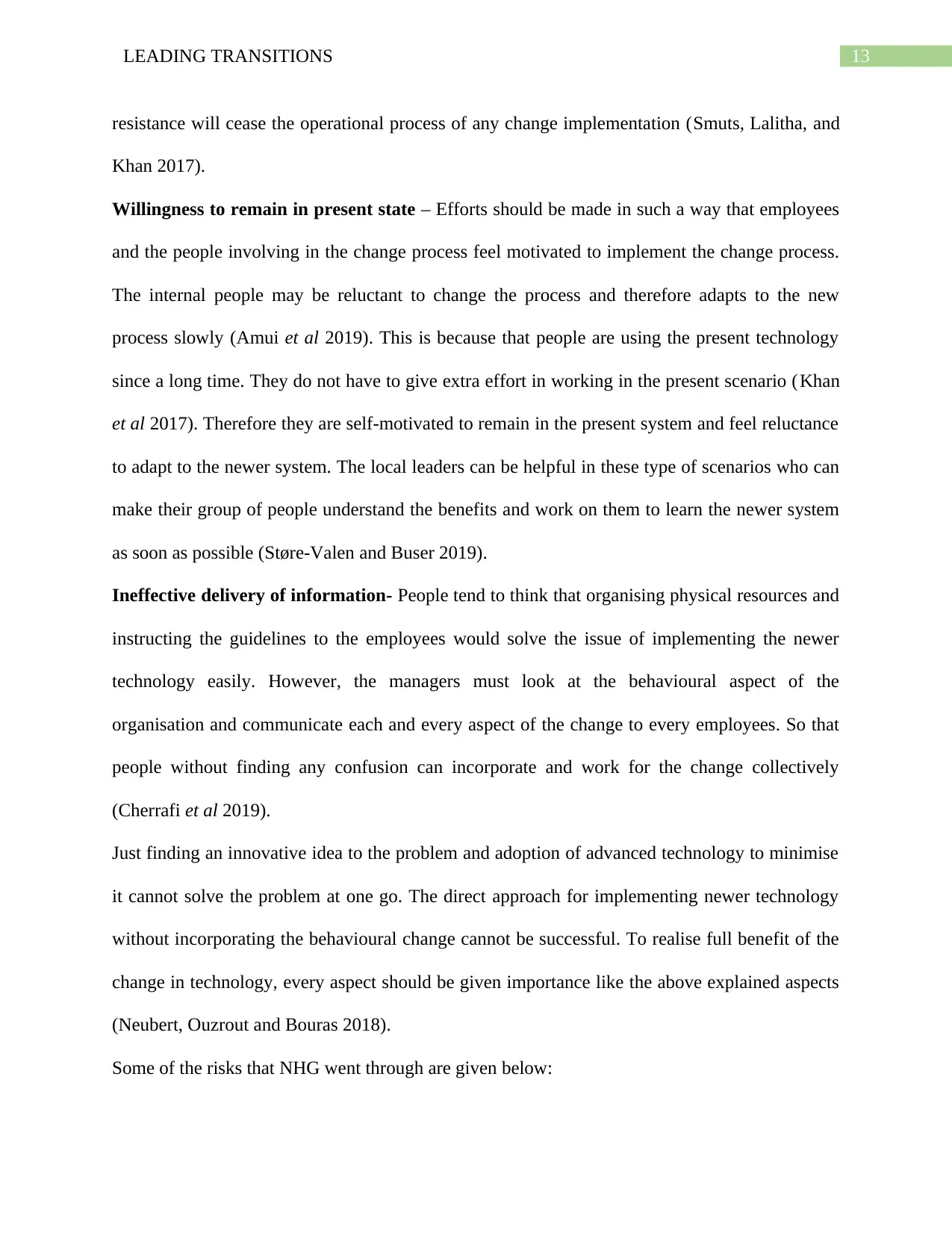
13LEADING TRANSITIONS
resistance will cease the operational process of any change implementation (Smuts, Lalitha, and
Khan 2017).
Willingness to remain in present state – Efforts should be made in such a way that employees
and the people involving in the change process feel motivated to implement the change process.
The internal people may be reluctant to change the process and therefore adapts to the new
process slowly (Amui et al 2019). This is because that people are using the present technology
since a long time. They do not have to give extra effort in working in the present scenario (Khan
et al 2017). Therefore they are self-motivated to remain in the present system and feel reluctance
to adapt to the newer system. The local leaders can be helpful in these type of scenarios who can
make their group of people understand the benefits and work on them to learn the newer system
as soon as possible (Støre-Valen and Buser 2019).
Ineffective delivery of information- People tend to think that organising physical resources and
instructing the guidelines to the employees would solve the issue of implementing the newer
technology easily. However, the managers must look at the behavioural aspect of the
organisation and communicate each and every aspect of the change to every employees. So that
people without finding any confusion can incorporate and work for the change collectively
(Cherrafi et al 2019).
Just finding an innovative idea to the problem and adoption of advanced technology to minimise
it cannot solve the problem at one go. The direct approach for implementing newer technology
without incorporating the behavioural change cannot be successful. To realise full benefit of the
change in technology, every aspect should be given importance like the above explained aspects
(Neubert, Ouzrout and Bouras 2018).
Some of the risks that NHG went through are given below:
resistance will cease the operational process of any change implementation (Smuts, Lalitha, and
Khan 2017).
Willingness to remain in present state – Efforts should be made in such a way that employees
and the people involving in the change process feel motivated to implement the change process.
The internal people may be reluctant to change the process and therefore adapts to the new
process slowly (Amui et al 2019). This is because that people are using the present technology
since a long time. They do not have to give extra effort in working in the present scenario (Khan
et al 2017). Therefore they are self-motivated to remain in the present system and feel reluctance
to adapt to the newer system. The local leaders can be helpful in these type of scenarios who can
make their group of people understand the benefits and work on them to learn the newer system
as soon as possible (Støre-Valen and Buser 2019).
Ineffective delivery of information- People tend to think that organising physical resources and
instructing the guidelines to the employees would solve the issue of implementing the newer
technology easily. However, the managers must look at the behavioural aspect of the
organisation and communicate each and every aspect of the change to every employees. So that
people without finding any confusion can incorporate and work for the change collectively
(Cherrafi et al 2019).
Just finding an innovative idea to the problem and adoption of advanced technology to minimise
it cannot solve the problem at one go. The direct approach for implementing newer technology
without incorporating the behavioural change cannot be successful. To realise full benefit of the
change in technology, every aspect should be given importance like the above explained aspects
(Neubert, Ouzrout and Bouras 2018).
Some of the risks that NHG went through are given below:
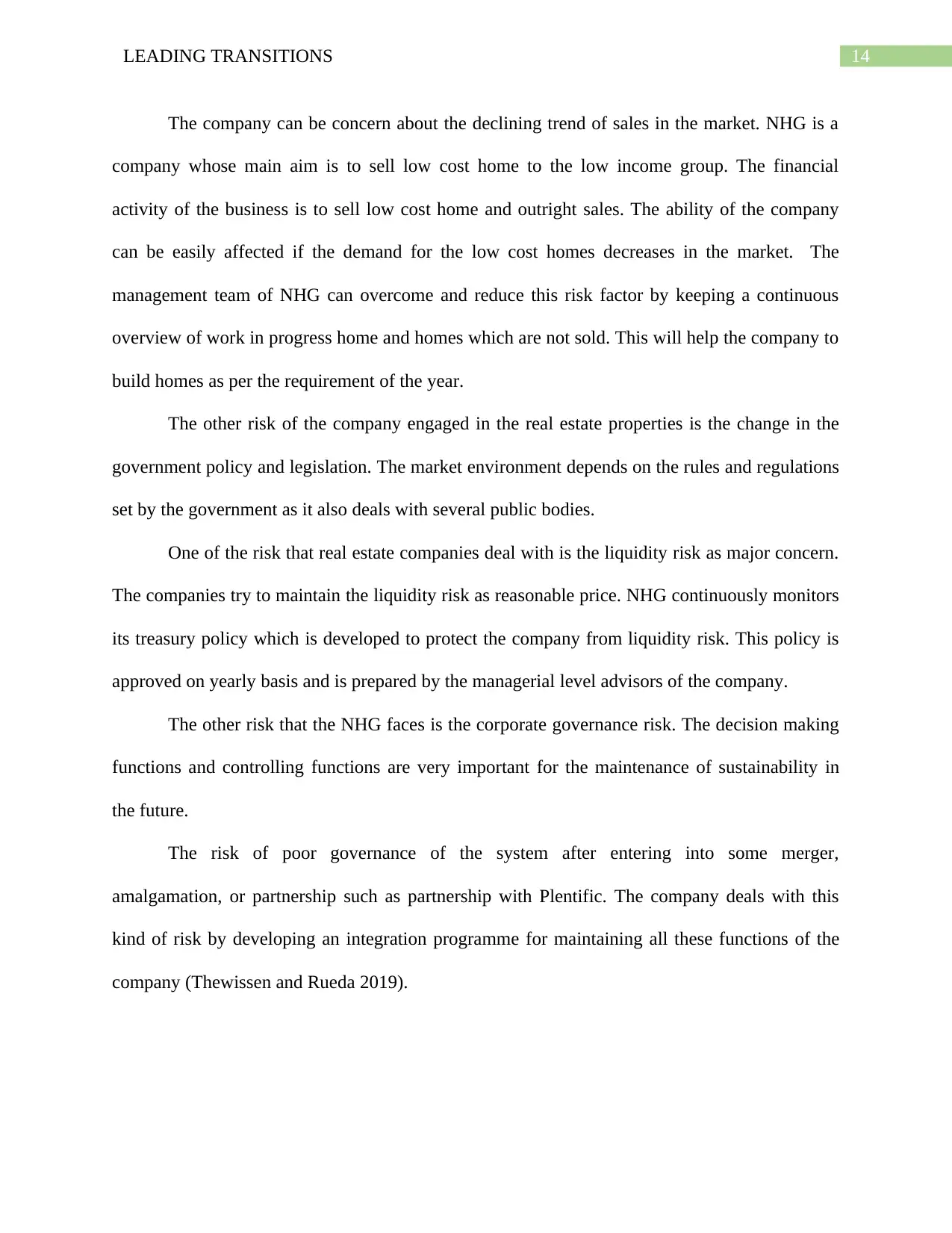
14LEADING TRANSITIONS
The company can be concern about the declining trend of sales in the market. NHG is a
company whose main aim is to sell low cost home to the low income group. The financial
activity of the business is to sell low cost home and outright sales. The ability of the company
can be easily affected if the demand for the low cost homes decreases in the market. The
management team of NHG can overcome and reduce this risk factor by keeping a continuous
overview of work in progress home and homes which are not sold. This will help the company to
build homes as per the requirement of the year.
The other risk of the company engaged in the real estate properties is the change in the
government policy and legislation. The market environment depends on the rules and regulations
set by the government as it also deals with several public bodies.
One of the risk that real estate companies deal with is the liquidity risk as major concern.
The companies try to maintain the liquidity risk as reasonable price. NHG continuously monitors
its treasury policy which is developed to protect the company from liquidity risk. This policy is
approved on yearly basis and is prepared by the managerial level advisors of the company.
The other risk that the NHG faces is the corporate governance risk. The decision making
functions and controlling functions are very important for the maintenance of sustainability in
the future.
The risk of poor governance of the system after entering into some merger,
amalgamation, or partnership such as partnership with Plentific. The company deals with this
kind of risk by developing an integration programme for maintaining all these functions of the
company (Thewissen and Rueda 2019).
The company can be concern about the declining trend of sales in the market. NHG is a
company whose main aim is to sell low cost home to the low income group. The financial
activity of the business is to sell low cost home and outright sales. The ability of the company
can be easily affected if the demand for the low cost homes decreases in the market. The
management team of NHG can overcome and reduce this risk factor by keeping a continuous
overview of work in progress home and homes which are not sold. This will help the company to
build homes as per the requirement of the year.
The other risk of the company engaged in the real estate properties is the change in the
government policy and legislation. The market environment depends on the rules and regulations
set by the government as it also deals with several public bodies.
One of the risk that real estate companies deal with is the liquidity risk as major concern.
The companies try to maintain the liquidity risk as reasonable price. NHG continuously monitors
its treasury policy which is developed to protect the company from liquidity risk. This policy is
approved on yearly basis and is prepared by the managerial level advisors of the company.
The other risk that the NHG faces is the corporate governance risk. The decision making
functions and controlling functions are very important for the maintenance of sustainability in
the future.
The risk of poor governance of the system after entering into some merger,
amalgamation, or partnership such as partnership with Plentific. The company deals with this
kind of risk by developing an integration programme for maintaining all these functions of the
company (Thewissen and Rueda 2019).
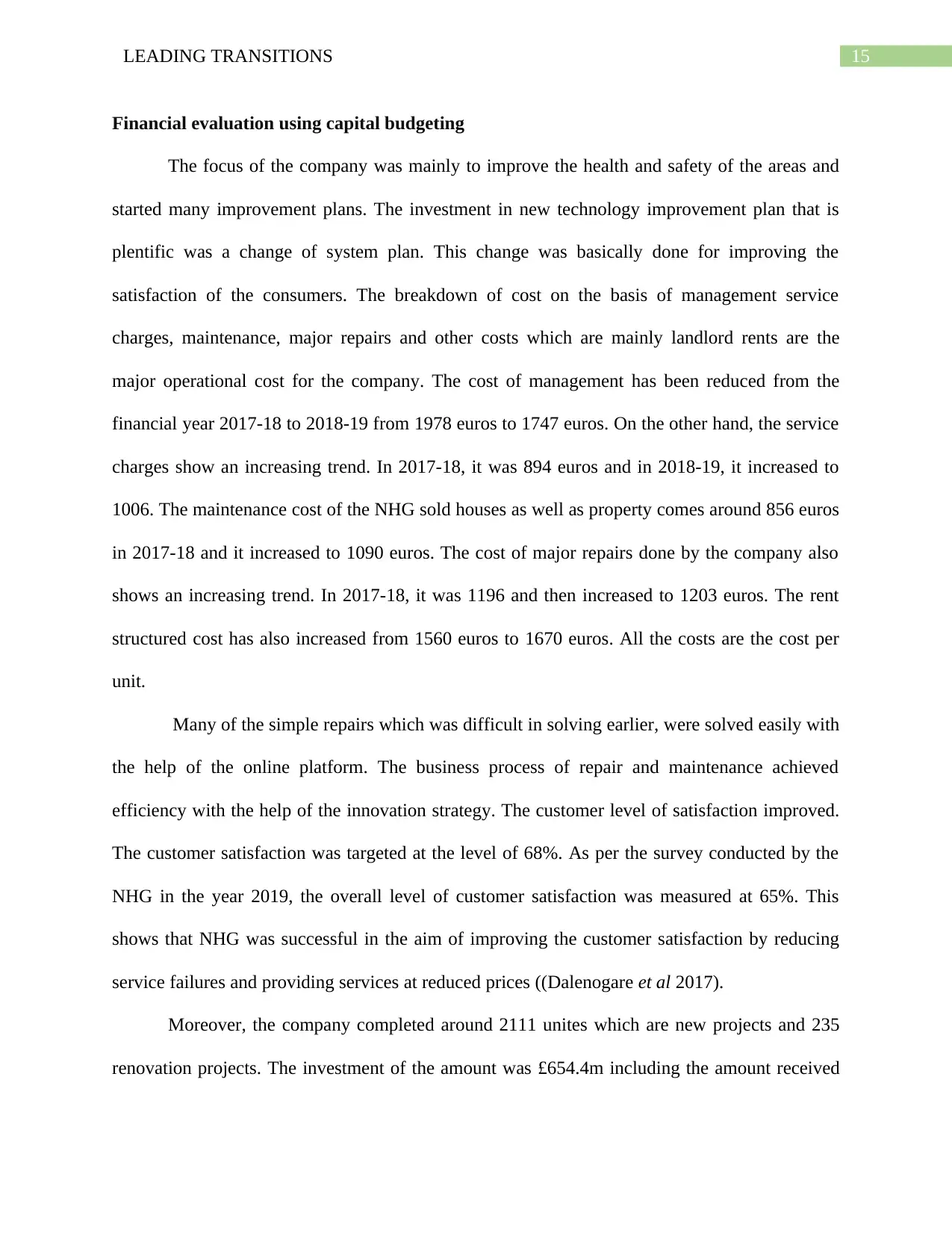
15LEADING TRANSITIONS
Financial evaluation using capital budgeting
The focus of the company was mainly to improve the health and safety of the areas and
started many improvement plans. The investment in new technology improvement plan that is
plentific was a change of system plan. This change was basically done for improving the
satisfaction of the consumers. The breakdown of cost on the basis of management service
charges, maintenance, major repairs and other costs which are mainly landlord rents are the
major operational cost for the company. The cost of management has been reduced from the
financial year 2017-18 to 2018-19 from 1978 euros to 1747 euros. On the other hand, the service
charges show an increasing trend. In 2017-18, it was 894 euros and in 2018-19, it increased to
1006. The maintenance cost of the NHG sold houses as well as property comes around 856 euros
in 2017-18 and it increased to 1090 euros. The cost of major repairs done by the company also
shows an increasing trend. In 2017-18, it was 1196 and then increased to 1203 euros. The rent
structured cost has also increased from 1560 euros to 1670 euros. All the costs are the cost per
unit.
Many of the simple repairs which was difficult in solving earlier, were solved easily with
the help of the online platform. The business process of repair and maintenance achieved
efficiency with the help of the innovation strategy. The customer level of satisfaction improved.
The customer satisfaction was targeted at the level of 68%. As per the survey conducted by the
NHG in the year 2019, the overall level of customer satisfaction was measured at 65%. This
shows that NHG was successful in the aim of improving the customer satisfaction by reducing
service failures and providing services at reduced prices ((Dalenogare et al 2017).
Moreover, the company completed around 2111 unites which are new projects and 235
renovation projects. The investment of the amount was £654.4m including the amount received
Financial evaluation using capital budgeting
The focus of the company was mainly to improve the health and safety of the areas and
started many improvement plans. The investment in new technology improvement plan that is
plentific was a change of system plan. This change was basically done for improving the
satisfaction of the consumers. The breakdown of cost on the basis of management service
charges, maintenance, major repairs and other costs which are mainly landlord rents are the
major operational cost for the company. The cost of management has been reduced from the
financial year 2017-18 to 2018-19 from 1978 euros to 1747 euros. On the other hand, the service
charges show an increasing trend. In 2017-18, it was 894 euros and in 2018-19, it increased to
1006. The maintenance cost of the NHG sold houses as well as property comes around 856 euros
in 2017-18 and it increased to 1090 euros. The cost of major repairs done by the company also
shows an increasing trend. In 2017-18, it was 1196 and then increased to 1203 euros. The rent
structured cost has also increased from 1560 euros to 1670 euros. All the costs are the cost per
unit.
Many of the simple repairs which was difficult in solving earlier, were solved easily with
the help of the online platform. The business process of repair and maintenance achieved
efficiency with the help of the innovation strategy. The customer level of satisfaction improved.
The customer satisfaction was targeted at the level of 68%. As per the survey conducted by the
NHG in the year 2019, the overall level of customer satisfaction was measured at 65%. This
shows that NHG was successful in the aim of improving the customer satisfaction by reducing
service failures and providing services at reduced prices ((Dalenogare et al 2017).
Moreover, the company completed around 2111 unites which are new projects and 235
renovation projects. The investment of the amount was £654.4m including the amount received
Secure Best Marks with AI Grader
Need help grading? Try our AI Grader for instant feedback on your assignments.
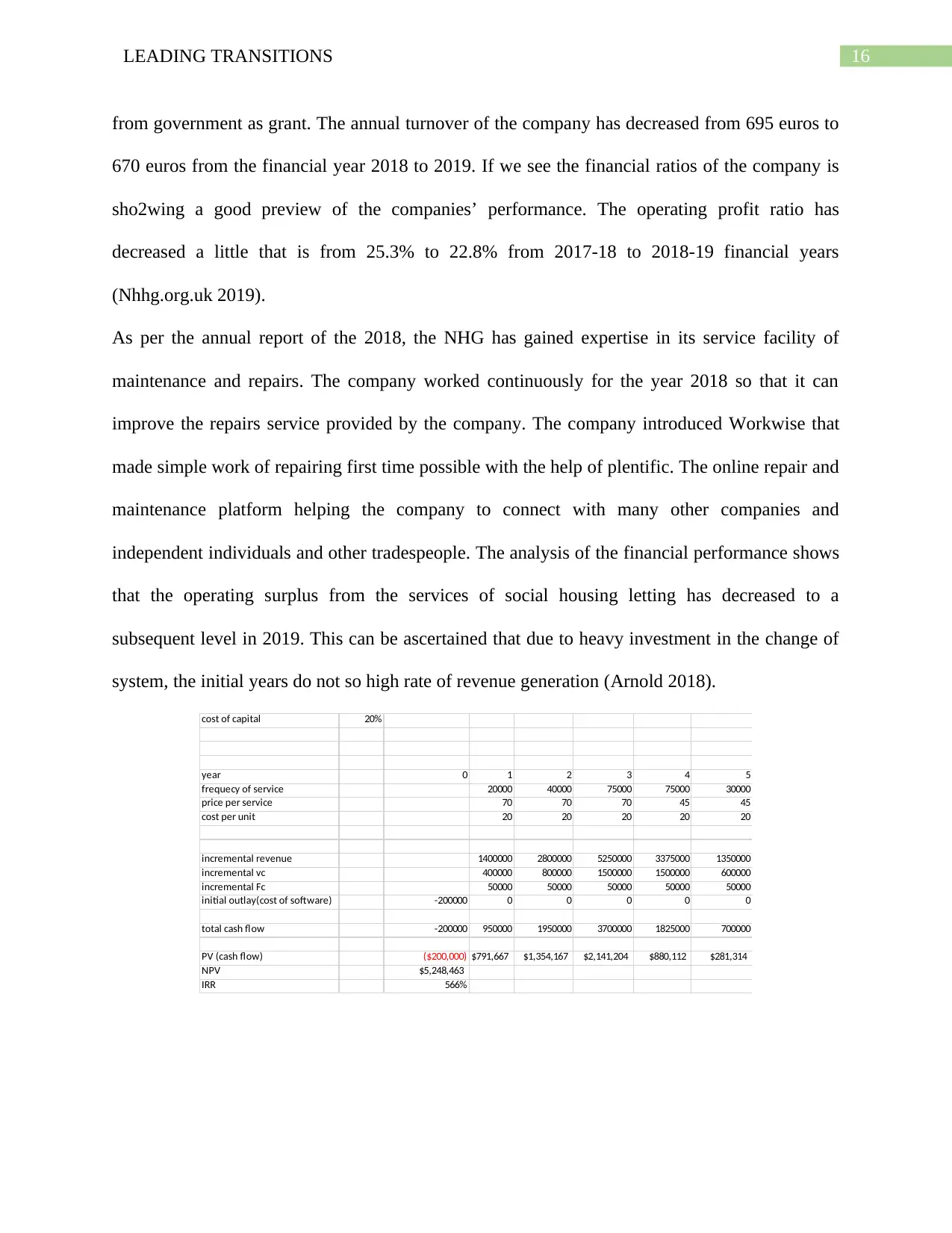
16LEADING TRANSITIONS
from government as grant. The annual turnover of the company has decreased from 695 euros to
670 euros from the financial year 2018 to 2019. If we see the financial ratios of the company is
sho2wing a good preview of the companies’ performance. The operating profit ratio has
decreased a little that is from 25.3% to 22.8% from 2017-18 to 2018-19 financial years
(Nhhg.org.uk 2019).
As per the annual report of the 2018, the NHG has gained expertise in its service facility of
maintenance and repairs. The company worked continuously for the year 2018 so that it can
improve the repairs service provided by the company. The company introduced Workwise that
made simple work of repairing first time possible with the help of plentific. The online repair and
maintenance platform helping the company to connect with many other companies and
independent individuals and other tradespeople. The analysis of the financial performance shows
that the operating surplus from the services of social housing letting has decreased to a
subsequent level in 2019. This can be ascertained that due to heavy investment in the change of
system, the initial years do not so high rate of revenue generation (Arnold 2018).
cost of capital 20%
year 0 1 2 3 4 5
frequecy of service 20000 40000 75000 75000 30000
price per service 70 70 70 45 45
cost per unit 20 20 20 20 20
incremental revenue 1400000 2800000 5250000 3375000 1350000
incremental vc 400000 800000 1500000 1500000 600000
incremental Fc 50000 50000 50000 50000 50000
initial outlay(cost of software) -200000 0 0 0 0 0
total cash flow -200000 950000 1950000 3700000 1825000 700000
PV (cash flow) ($200,000) $791,667 $1,354,167 $2,141,204 $880,112 $281,314
NPV $5,248,463
IRR 566%
from government as grant. The annual turnover of the company has decreased from 695 euros to
670 euros from the financial year 2018 to 2019. If we see the financial ratios of the company is
sho2wing a good preview of the companies’ performance. The operating profit ratio has
decreased a little that is from 25.3% to 22.8% from 2017-18 to 2018-19 financial years
(Nhhg.org.uk 2019).
As per the annual report of the 2018, the NHG has gained expertise in its service facility of
maintenance and repairs. The company worked continuously for the year 2018 so that it can
improve the repairs service provided by the company. The company introduced Workwise that
made simple work of repairing first time possible with the help of plentific. The online repair and
maintenance platform helping the company to connect with many other companies and
independent individuals and other tradespeople. The analysis of the financial performance shows
that the operating surplus from the services of social housing letting has decreased to a
subsequent level in 2019. This can be ascertained that due to heavy investment in the change of
system, the initial years do not so high rate of revenue generation (Arnold 2018).
cost of capital 20%
year 0 1 2 3 4 5
frequecy of service 20000 40000 75000 75000 30000
price per service 70 70 70 45 45
cost per unit 20 20 20 20 20
incremental revenue 1400000 2800000 5250000 3375000 1350000
incremental vc 400000 800000 1500000 1500000 600000
incremental Fc 50000 50000 50000 50000 50000
initial outlay(cost of software) -200000 0 0 0 0 0
total cash flow -200000 950000 1950000 3700000 1825000 700000
PV (cash flow) ($200,000) $791,667 $1,354,167 $2,141,204 $880,112 $281,314
NPV $5,248,463
IRR 566%
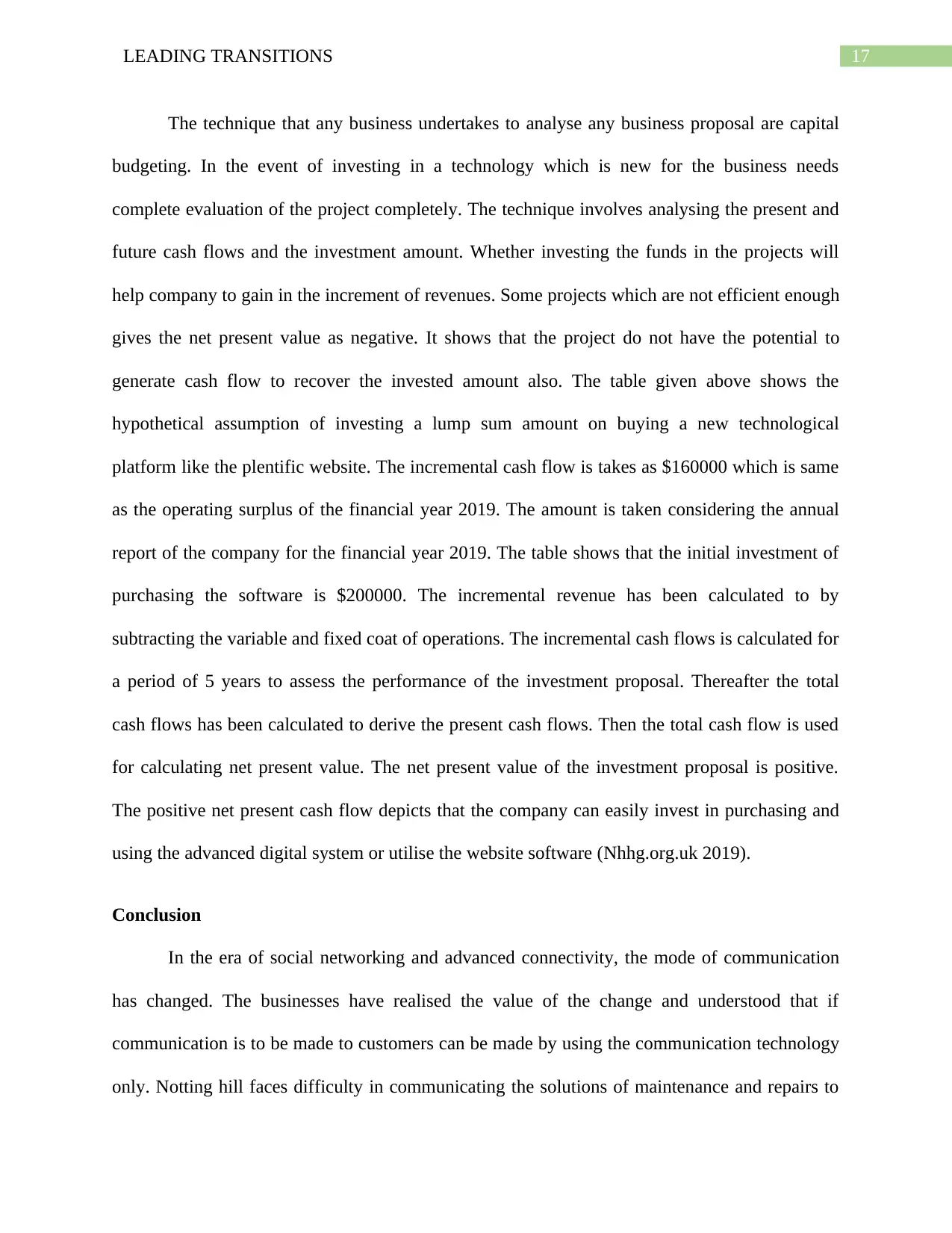
17LEADING TRANSITIONS
The technique that any business undertakes to analyse any business proposal are capital
budgeting. In the event of investing in a technology which is new for the business needs
complete evaluation of the project completely. The technique involves analysing the present and
future cash flows and the investment amount. Whether investing the funds in the projects will
help company to gain in the increment of revenues. Some projects which are not efficient enough
gives the net present value as negative. It shows that the project do not have the potential to
generate cash flow to recover the invested amount also. The table given above shows the
hypothetical assumption of investing a lump sum amount on buying a new technological
platform like the plentific website. The incremental cash flow is takes as $160000 which is same
as the operating surplus of the financial year 2019. The amount is taken considering the annual
report of the company for the financial year 2019. The table shows that the initial investment of
purchasing the software is $200000. The incremental revenue has been calculated to by
subtracting the variable and fixed coat of operations. The incremental cash flows is calculated for
a period of 5 years to assess the performance of the investment proposal. Thereafter the total
cash flows has been calculated to derive the present cash flows. Then the total cash flow is used
for calculating net present value. The net present value of the investment proposal is positive.
The positive net present cash flow depicts that the company can easily invest in purchasing and
using the advanced digital system or utilise the website software (Nhhg.org.uk 2019).
Conclusion
In the era of social networking and advanced connectivity, the mode of communication
has changed. The businesses have realised the value of the change and understood that if
communication is to be made to customers can be made by using the communication technology
only. Notting hill faces difficulty in communicating the solutions of maintenance and repairs to
The technique that any business undertakes to analyse any business proposal are capital
budgeting. In the event of investing in a technology which is new for the business needs
complete evaluation of the project completely. The technique involves analysing the present and
future cash flows and the investment amount. Whether investing the funds in the projects will
help company to gain in the increment of revenues. Some projects which are not efficient enough
gives the net present value as negative. It shows that the project do not have the potential to
generate cash flow to recover the invested amount also. The table given above shows the
hypothetical assumption of investing a lump sum amount on buying a new technological
platform like the plentific website. The incremental cash flow is takes as $160000 which is same
as the operating surplus of the financial year 2019. The amount is taken considering the annual
report of the company for the financial year 2019. The table shows that the initial investment of
purchasing the software is $200000. The incremental revenue has been calculated to by
subtracting the variable and fixed coat of operations. The incremental cash flows is calculated for
a period of 5 years to assess the performance of the investment proposal. Thereafter the total
cash flows has been calculated to derive the present cash flows. Then the total cash flow is used
for calculating net present value. The net present value of the investment proposal is positive.
The positive net present cash flow depicts that the company can easily invest in purchasing and
using the advanced digital system or utilise the website software (Nhhg.org.uk 2019).
Conclusion
In the era of social networking and advanced connectivity, the mode of communication
has changed. The businesses have realised the value of the change and understood that if
communication is to be made to customers can be made by using the communication technology
only. Notting hill faces difficulty in communicating the solutions of maintenance and repairs to
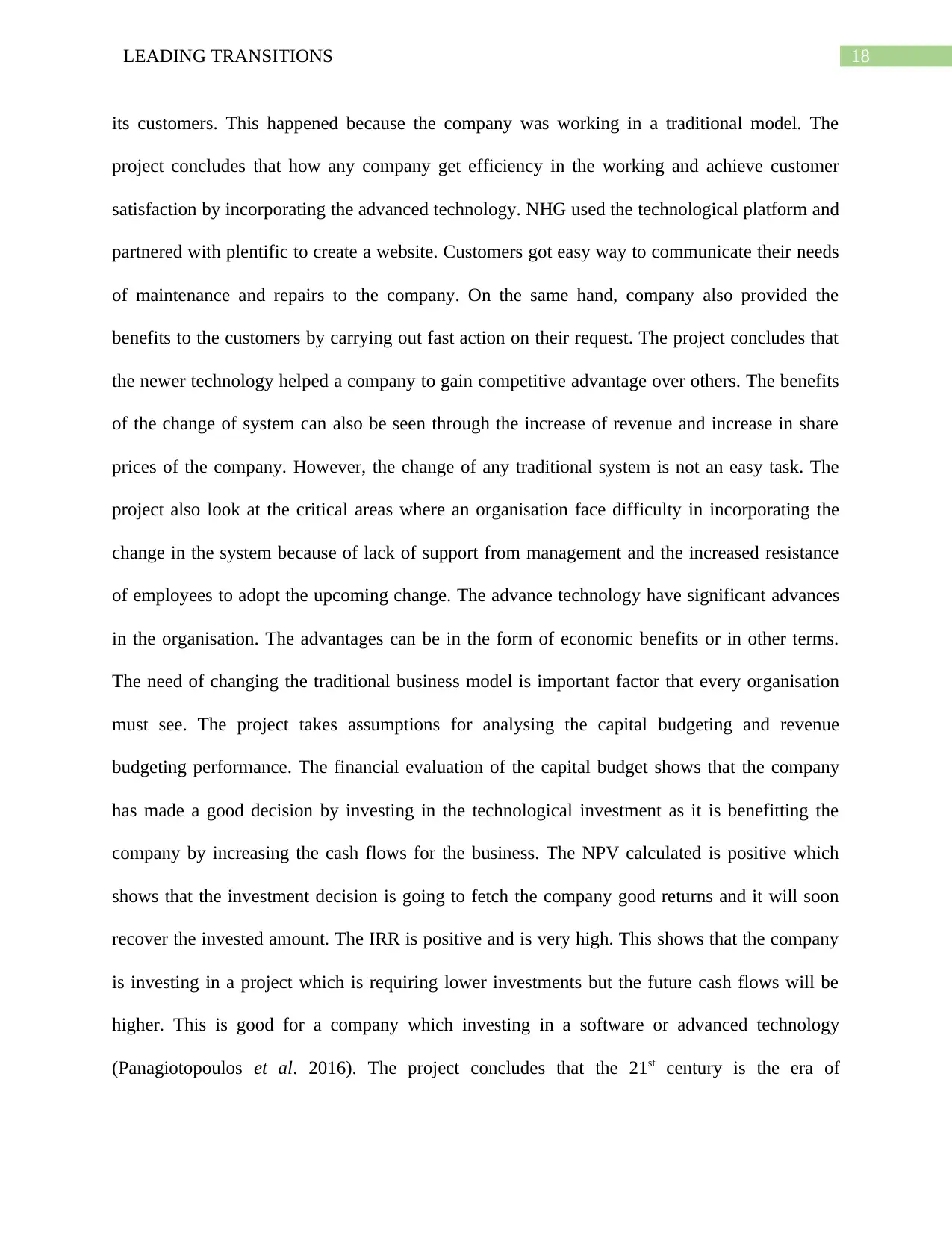
18LEADING TRANSITIONS
its customers. This happened because the company was working in a traditional model. The
project concludes that how any company get efficiency in the working and achieve customer
satisfaction by incorporating the advanced technology. NHG used the technological platform and
partnered with plentific to create a website. Customers got easy way to communicate their needs
of maintenance and repairs to the company. On the same hand, company also provided the
benefits to the customers by carrying out fast action on their request. The project concludes that
the newer technology helped a company to gain competitive advantage over others. The benefits
of the change of system can also be seen through the increase of revenue and increase in share
prices of the company. However, the change of any traditional system is not an easy task. The
project also look at the critical areas where an organisation face difficulty in incorporating the
change in the system because of lack of support from management and the increased resistance
of employees to adopt the upcoming change. The advance technology have significant advances
in the organisation. The advantages can be in the form of economic benefits or in other terms.
The need of changing the traditional business model is important factor that every organisation
must see. The project takes assumptions for analysing the capital budgeting and revenue
budgeting performance. The financial evaluation of the capital budget shows that the company
has made a good decision by investing in the technological investment as it is benefitting the
company by increasing the cash flows for the business. The NPV calculated is positive which
shows that the investment decision is going to fetch the company good returns and it will soon
recover the invested amount. The IRR is positive and is very high. This shows that the company
is investing in a project which is requiring lower investments but the future cash flows will be
higher. This is good for a company which investing in a software or advanced technology
(Panagiotopoulos et al. 2016). The project concludes that the 21st century is the era of
its customers. This happened because the company was working in a traditional model. The
project concludes that how any company get efficiency in the working and achieve customer
satisfaction by incorporating the advanced technology. NHG used the technological platform and
partnered with plentific to create a website. Customers got easy way to communicate their needs
of maintenance and repairs to the company. On the same hand, company also provided the
benefits to the customers by carrying out fast action on their request. The project concludes that
the newer technology helped a company to gain competitive advantage over others. The benefits
of the change of system can also be seen through the increase of revenue and increase in share
prices of the company. However, the change of any traditional system is not an easy task. The
project also look at the critical areas where an organisation face difficulty in incorporating the
change in the system because of lack of support from management and the increased resistance
of employees to adopt the upcoming change. The advance technology have significant advances
in the organisation. The advantages can be in the form of economic benefits or in other terms.
The need of changing the traditional business model is important factor that every organisation
must see. The project takes assumptions for analysing the capital budgeting and revenue
budgeting performance. The financial evaluation of the capital budget shows that the company
has made a good decision by investing in the technological investment as it is benefitting the
company by increasing the cash flows for the business. The NPV calculated is positive which
shows that the investment decision is going to fetch the company good returns and it will soon
recover the invested amount. The IRR is positive and is very high. This shows that the company
is investing in a project which is requiring lower investments but the future cash flows will be
higher. This is good for a company which investing in a software or advanced technology
(Panagiotopoulos et al. 2016). The project concludes that the 21st century is the era of
Paraphrase This Document
Need a fresh take? Get an instant paraphrase of this document with our AI Paraphraser
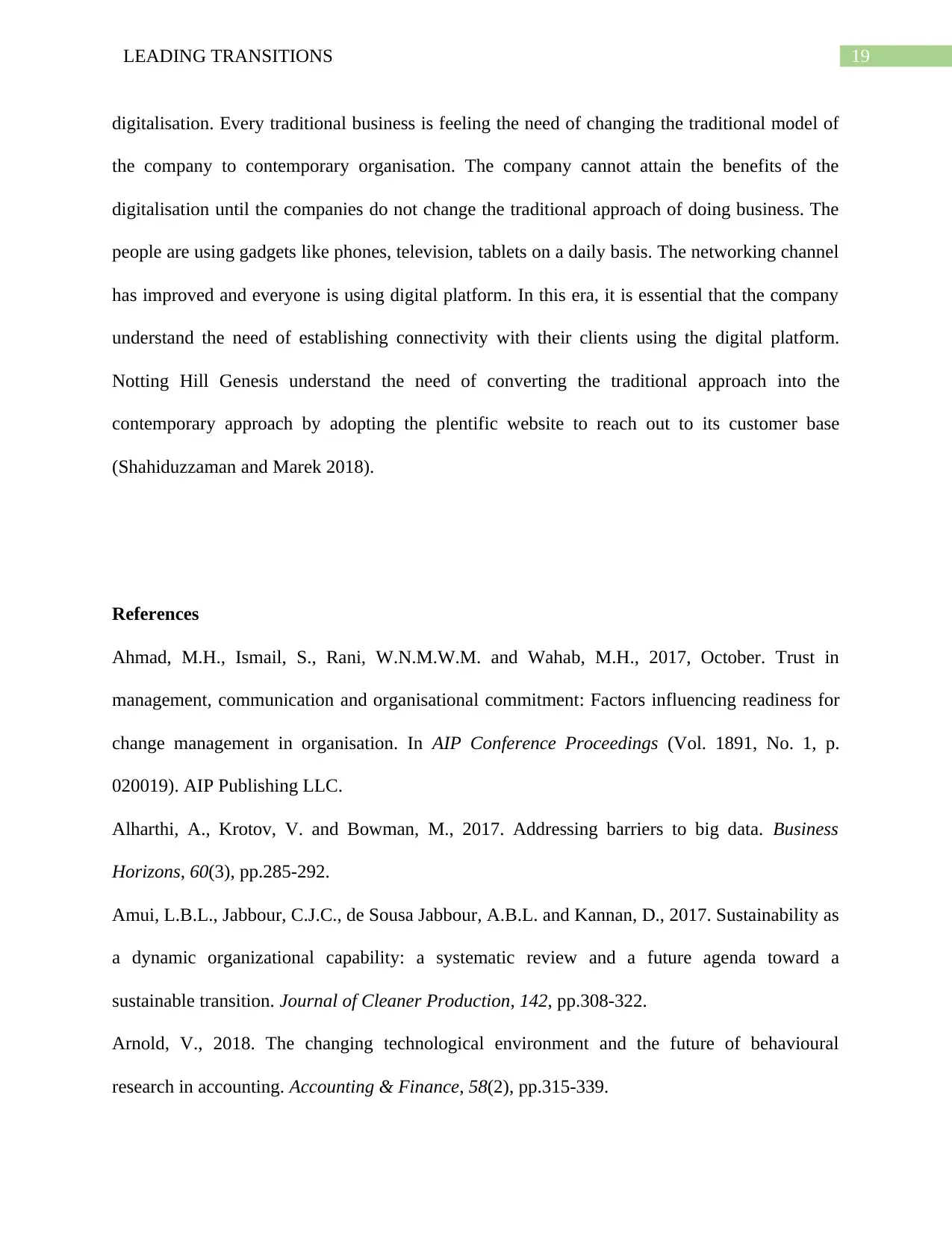
19LEADING TRANSITIONS
digitalisation. Every traditional business is feeling the need of changing the traditional model of
the company to contemporary organisation. The company cannot attain the benefits of the
digitalisation until the companies do not change the traditional approach of doing business. The
people are using gadgets like phones, television, tablets on a daily basis. The networking channel
has improved and everyone is using digital platform. In this era, it is essential that the company
understand the need of establishing connectivity with their clients using the digital platform.
Notting Hill Genesis understand the need of converting the traditional approach into the
contemporary approach by adopting the plentific website to reach out to its customer base
(Shahiduzzaman and Marek 2018).
References
Ahmad, M.H., Ismail, S., Rani, W.N.M.W.M. and Wahab, M.H., 2017, October. Trust in
management, communication and organisational commitment: Factors influencing readiness for
change management in organisation. In AIP Conference Proceedings (Vol. 1891, No. 1, p.
020019). AIP Publishing LLC.
Alharthi, A., Krotov, V. and Bowman, M., 2017. Addressing barriers to big data. Business
Horizons, 60(3), pp.285-292.
Amui, L.B.L., Jabbour, C.J.C., de Sousa Jabbour, A.B.L. and Kannan, D., 2017. Sustainability as
a dynamic organizational capability: a systematic review and a future agenda toward a
sustainable transition. Journal of Cleaner Production, 142, pp.308-322.
Arnold, V., 2018. The changing technological environment and the future of behavioural
research in accounting. Accounting & Finance, 58(2), pp.315-339.
digitalisation. Every traditional business is feeling the need of changing the traditional model of
the company to contemporary organisation. The company cannot attain the benefits of the
digitalisation until the companies do not change the traditional approach of doing business. The
people are using gadgets like phones, television, tablets on a daily basis. The networking channel
has improved and everyone is using digital platform. In this era, it is essential that the company
understand the need of establishing connectivity with their clients using the digital platform.
Notting Hill Genesis understand the need of converting the traditional approach into the
contemporary approach by adopting the plentific website to reach out to its customer base
(Shahiduzzaman and Marek 2018).
References
Ahmad, M.H., Ismail, S., Rani, W.N.M.W.M. and Wahab, M.H., 2017, October. Trust in
management, communication and organisational commitment: Factors influencing readiness for
change management in organisation. In AIP Conference Proceedings (Vol. 1891, No. 1, p.
020019). AIP Publishing LLC.
Alharthi, A., Krotov, V. and Bowman, M., 2017. Addressing barriers to big data. Business
Horizons, 60(3), pp.285-292.
Amui, L.B.L., Jabbour, C.J.C., de Sousa Jabbour, A.B.L. and Kannan, D., 2017. Sustainability as
a dynamic organizational capability: a systematic review and a future agenda toward a
sustainable transition. Journal of Cleaner Production, 142, pp.308-322.
Arnold, V., 2018. The changing technological environment and the future of behavioural
research in accounting. Accounting & Finance, 58(2), pp.315-339.
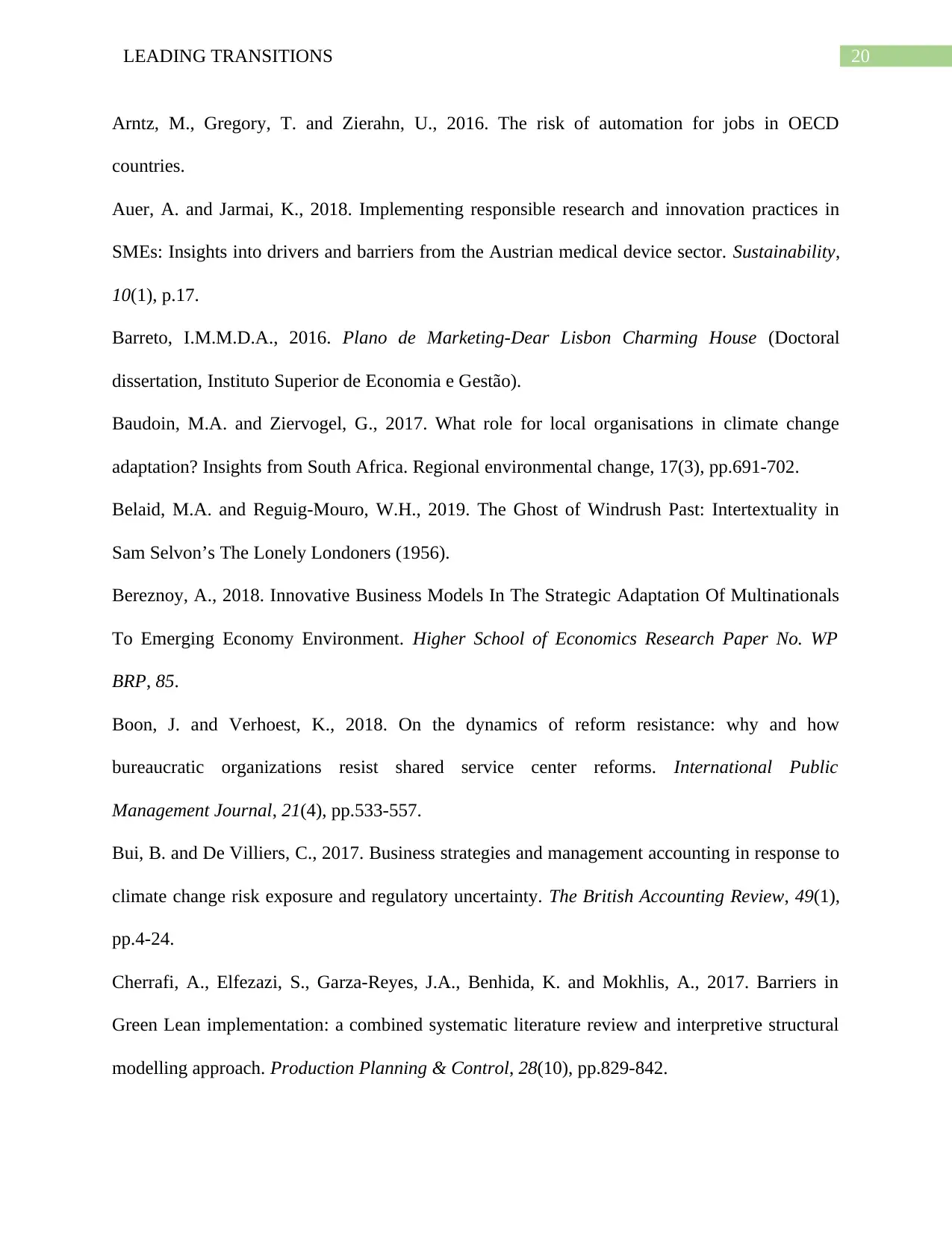
20LEADING TRANSITIONS
Arntz, M., Gregory, T. and Zierahn, U., 2016. The risk of automation for jobs in OECD
countries.
Auer, A. and Jarmai, K., 2018. Implementing responsible research and innovation practices in
SMEs: Insights into drivers and barriers from the Austrian medical device sector. Sustainability,
10(1), p.17.
Barreto, I.M.M.D.A., 2016. Plano de Marketing-Dear Lisbon Charming House (Doctoral
dissertation, Instituto Superior de Economia e Gestão).
Baudoin, M.A. and Ziervogel, G., 2017. What role for local organisations in climate change
adaptation? Insights from South Africa. Regional environmental change, 17(3), pp.691-702.
Belaid, M.A. and Reguig-Mouro, W.H., 2019. The Ghost of Windrush Past: Intertextuality in
Sam Selvon’s The Lonely Londoners (1956).
Bereznoy, A., 2018. Innovative Business Models In The Strategic Adaptation Of Multinationals
To Emerging Economy Environment. Higher School of Economics Research Paper No. WP
BRP, 85.
Boon, J. and Verhoest, K., 2018. On the dynamics of reform resistance: why and how
bureaucratic organizations resist shared service center reforms. International Public
Management Journal, 21(4), pp.533-557.
Bui, B. and De Villiers, C., 2017. Business strategies and management accounting in response to
climate change risk exposure and regulatory uncertainty. The British Accounting Review, 49(1),
pp.4-24.
Cherrafi, A., Elfezazi, S., Garza-Reyes, J.A., Benhida, K. and Mokhlis, A., 2017. Barriers in
Green Lean implementation: a combined systematic literature review and interpretive structural
modelling approach. Production Planning & Control, 28(10), pp.829-842.
Arntz, M., Gregory, T. and Zierahn, U., 2016. The risk of automation for jobs in OECD
countries.
Auer, A. and Jarmai, K., 2018. Implementing responsible research and innovation practices in
SMEs: Insights into drivers and barriers from the Austrian medical device sector. Sustainability,
10(1), p.17.
Barreto, I.M.M.D.A., 2016. Plano de Marketing-Dear Lisbon Charming House (Doctoral
dissertation, Instituto Superior de Economia e Gestão).
Baudoin, M.A. and Ziervogel, G., 2017. What role for local organisations in climate change
adaptation? Insights from South Africa. Regional environmental change, 17(3), pp.691-702.
Belaid, M.A. and Reguig-Mouro, W.H., 2019. The Ghost of Windrush Past: Intertextuality in
Sam Selvon’s The Lonely Londoners (1956).
Bereznoy, A., 2018. Innovative Business Models In The Strategic Adaptation Of Multinationals
To Emerging Economy Environment. Higher School of Economics Research Paper No. WP
BRP, 85.
Boon, J. and Verhoest, K., 2018. On the dynamics of reform resistance: why and how
bureaucratic organizations resist shared service center reforms. International Public
Management Journal, 21(4), pp.533-557.
Bui, B. and De Villiers, C., 2017. Business strategies and management accounting in response to
climate change risk exposure and regulatory uncertainty. The British Accounting Review, 49(1),
pp.4-24.
Cherrafi, A., Elfezazi, S., Garza-Reyes, J.A., Benhida, K. and Mokhlis, A., 2017. Barriers in
Green Lean implementation: a combined systematic literature review and interpretive structural
modelling approach. Production Planning & Control, 28(10), pp.829-842.
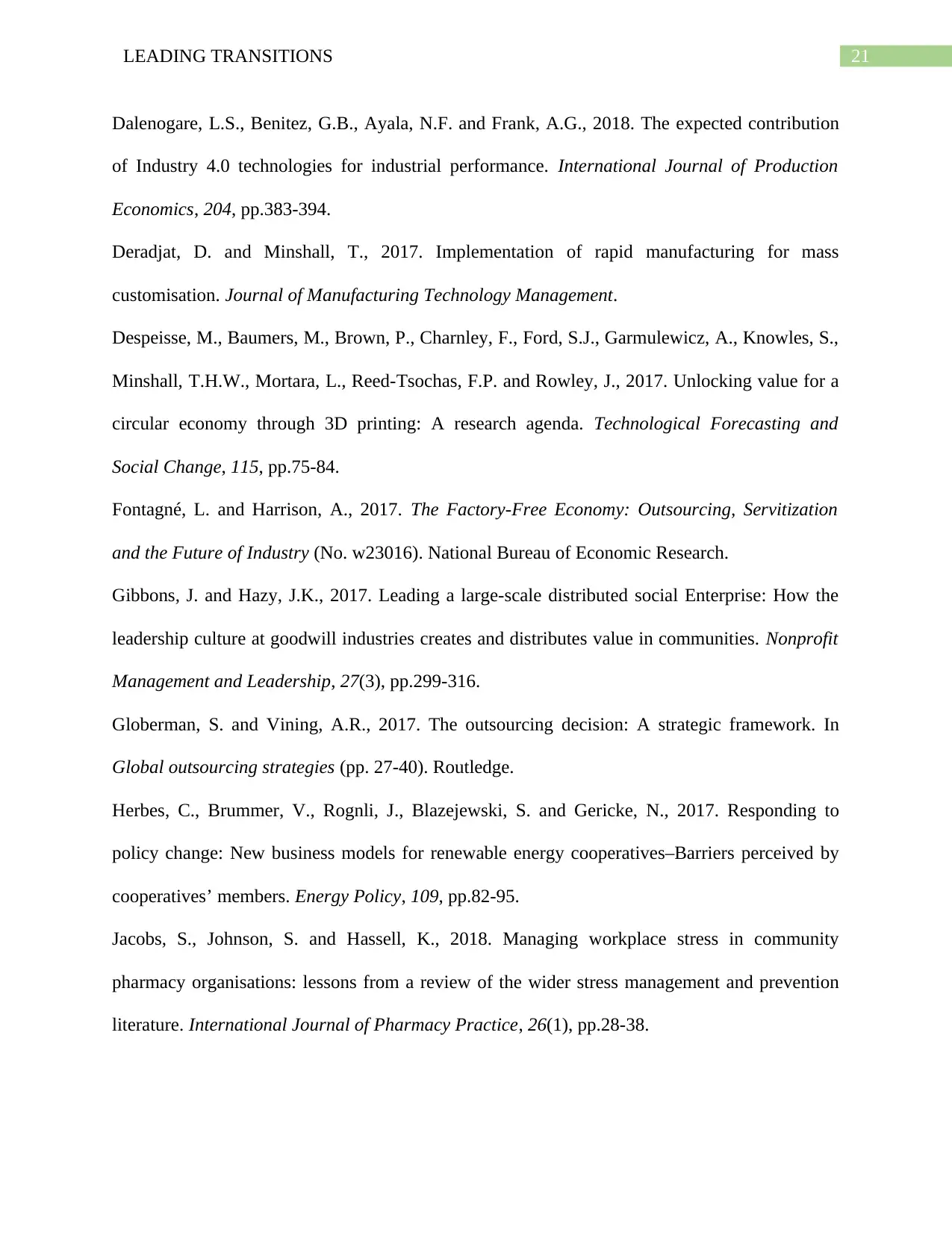
21LEADING TRANSITIONS
Dalenogare, L.S., Benitez, G.B., Ayala, N.F. and Frank, A.G., 2018. The expected contribution
of Industry 4.0 technologies for industrial performance. International Journal of Production
Economics, 204, pp.383-394.
Deradjat, D. and Minshall, T., 2017. Implementation of rapid manufacturing for mass
customisation. Journal of Manufacturing Technology Management.
Despeisse, M., Baumers, M., Brown, P., Charnley, F., Ford, S.J., Garmulewicz, A., Knowles, S.,
Minshall, T.H.W., Mortara, L., Reed-Tsochas, F.P. and Rowley, J., 2017. Unlocking value for a
circular economy through 3D printing: A research agenda. Technological Forecasting and
Social Change, 115, pp.75-84.
Fontagné, L. and Harrison, A., 2017. The Factory-Free Economy: Outsourcing, Servitization
and the Future of Industry (No. w23016). National Bureau of Economic Research.
Gibbons, J. and Hazy, J.K., 2017. Leading a large‐scale distributed social Enterprise: How the
leadership culture at goodwill industries creates and distributes value in communities. Nonprofit
Management and Leadership, 27(3), pp.299-316.
Globerman, S. and Vining, A.R., 2017. The outsourcing decision: A strategic framework. In
Global outsourcing strategies (pp. 27-40). Routledge.
Herbes, C., Brummer, V., Rognli, J., Blazejewski, S. and Gericke, N., 2017. Responding to
policy change: New business models for renewable energy cooperatives–Barriers perceived by
cooperatives’ members. Energy Policy, 109, pp.82-95.
Jacobs, S., Johnson, S. and Hassell, K., 2018. Managing workplace stress in community
pharmacy organisations: lessons from a review of the wider stress management and prevention
literature. International Journal of Pharmacy Practice, 26(1), pp.28-38.
Dalenogare, L.S., Benitez, G.B., Ayala, N.F. and Frank, A.G., 2018. The expected contribution
of Industry 4.0 technologies for industrial performance. International Journal of Production
Economics, 204, pp.383-394.
Deradjat, D. and Minshall, T., 2017. Implementation of rapid manufacturing for mass
customisation. Journal of Manufacturing Technology Management.
Despeisse, M., Baumers, M., Brown, P., Charnley, F., Ford, S.J., Garmulewicz, A., Knowles, S.,
Minshall, T.H.W., Mortara, L., Reed-Tsochas, F.P. and Rowley, J., 2017. Unlocking value for a
circular economy through 3D printing: A research agenda. Technological Forecasting and
Social Change, 115, pp.75-84.
Fontagné, L. and Harrison, A., 2017. The Factory-Free Economy: Outsourcing, Servitization
and the Future of Industry (No. w23016). National Bureau of Economic Research.
Gibbons, J. and Hazy, J.K., 2017. Leading a large‐scale distributed social Enterprise: How the
leadership culture at goodwill industries creates and distributes value in communities. Nonprofit
Management and Leadership, 27(3), pp.299-316.
Globerman, S. and Vining, A.R., 2017. The outsourcing decision: A strategic framework. In
Global outsourcing strategies (pp. 27-40). Routledge.
Herbes, C., Brummer, V., Rognli, J., Blazejewski, S. and Gericke, N., 2017. Responding to
policy change: New business models for renewable energy cooperatives–Barriers perceived by
cooperatives’ members. Energy Policy, 109, pp.82-95.
Jacobs, S., Johnson, S. and Hassell, K., 2018. Managing workplace stress in community
pharmacy organisations: lessons from a review of the wider stress management and prevention
literature. International Journal of Pharmacy Practice, 26(1), pp.28-38.
Secure Best Marks with AI Grader
Need help grading? Try our AI Grader for instant feedback on your assignments.
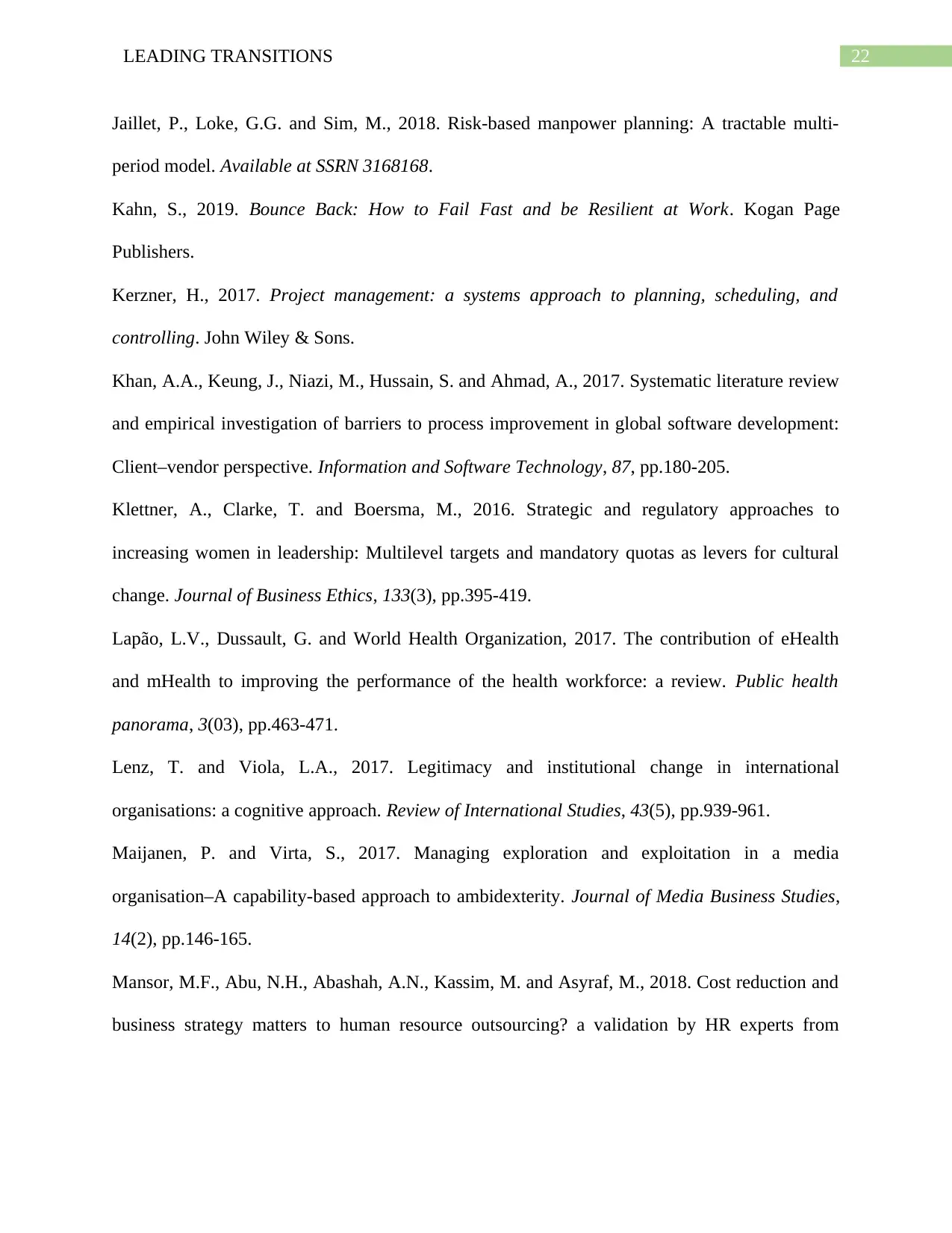
22LEADING TRANSITIONS
Jaillet, P., Loke, G.G. and Sim, M., 2018. Risk-based manpower planning: A tractable multi-
period model. Available at SSRN 3168168.
Kahn, S., 2019. Bounce Back: How to Fail Fast and be Resilient at Work. Kogan Page
Publishers.
Kerzner, H., 2017. Project management: a systems approach to planning, scheduling, and
controlling. John Wiley & Sons.
Khan, A.A., Keung, J., Niazi, M., Hussain, S. and Ahmad, A., 2017. Systematic literature review
and empirical investigation of barriers to process improvement in global software development:
Client–vendor perspective. Information and Software Technology, 87, pp.180-205.
Klettner, A., Clarke, T. and Boersma, M., 2016. Strategic and regulatory approaches to
increasing women in leadership: Multilevel targets and mandatory quotas as levers for cultural
change. Journal of Business Ethics, 133(3), pp.395-419.
Lapão, L.V., Dussault, G. and World Health Organization, 2017. The contribution of eHealth
and mHealth to improving the performance of the health workforce: a review. Public health
panorama, 3(03), pp.463-471.
Lenz, T. and Viola, L.A., 2017. Legitimacy and institutional change in international
organisations: a cognitive approach. Review of International Studies, 43(5), pp.939-961.
Maijanen, P. and Virta, S., 2017. Managing exploration and exploitation in a media
organisation–A capability-based approach to ambidexterity. Journal of Media Business Studies,
14(2), pp.146-165.
Mansor, M.F., Abu, N.H., Abashah, A.N., Kassim, M. and Asyraf, M., 2018. Cost reduction and
business strategy matters to human resource outsourcing? a validation by HR experts from
Jaillet, P., Loke, G.G. and Sim, M., 2018. Risk-based manpower planning: A tractable multi-
period model. Available at SSRN 3168168.
Kahn, S., 2019. Bounce Back: How to Fail Fast and be Resilient at Work. Kogan Page
Publishers.
Kerzner, H., 2017. Project management: a systems approach to planning, scheduling, and
controlling. John Wiley & Sons.
Khan, A.A., Keung, J., Niazi, M., Hussain, S. and Ahmad, A., 2017. Systematic literature review
and empirical investigation of barriers to process improvement in global software development:
Client–vendor perspective. Information and Software Technology, 87, pp.180-205.
Klettner, A., Clarke, T. and Boersma, M., 2016. Strategic and regulatory approaches to
increasing women in leadership: Multilevel targets and mandatory quotas as levers for cultural
change. Journal of Business Ethics, 133(3), pp.395-419.
Lapão, L.V., Dussault, G. and World Health Organization, 2017. The contribution of eHealth
and mHealth to improving the performance of the health workforce: a review. Public health
panorama, 3(03), pp.463-471.
Lenz, T. and Viola, L.A., 2017. Legitimacy and institutional change in international
organisations: a cognitive approach. Review of International Studies, 43(5), pp.939-961.
Maijanen, P. and Virta, S., 2017. Managing exploration and exploitation in a media
organisation–A capability-based approach to ambidexterity. Journal of Media Business Studies,
14(2), pp.146-165.
Mansor, M.F., Abu, N.H., Abashah, A.N., Kassim, M. and Asyraf, M., 2018. Cost reduction and
business strategy matters to human resource outsourcing? a validation by HR experts from
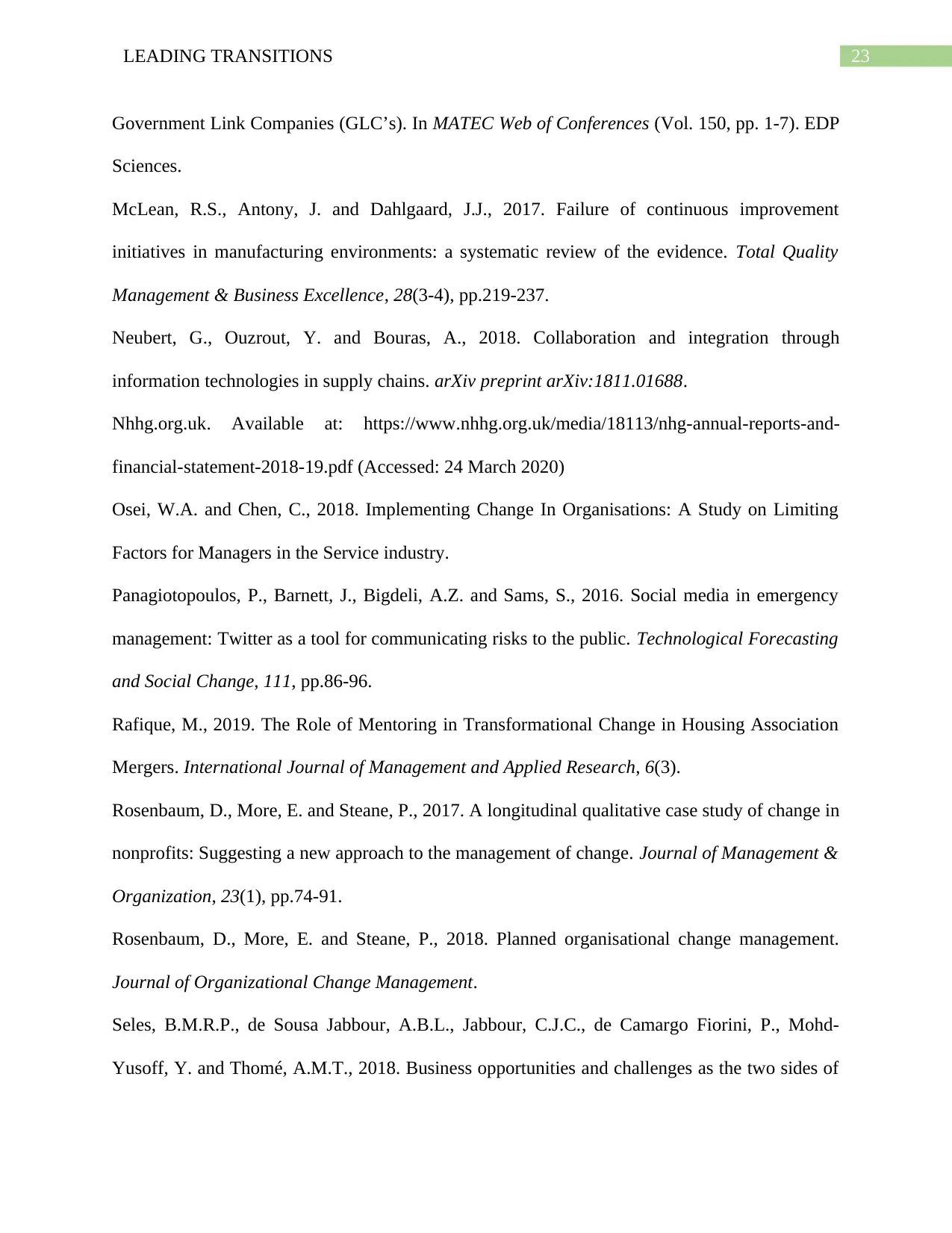
23LEADING TRANSITIONS
Government Link Companies (GLC’s). In MATEC Web of Conferences (Vol. 150, pp. 1-7). EDP
Sciences.
McLean, R.S., Antony, J. and Dahlgaard, J.J., 2017. Failure of continuous improvement
initiatives in manufacturing environments: a systematic review of the evidence. Total Quality
Management & Business Excellence, 28(3-4), pp.219-237.
Neubert, G., Ouzrout, Y. and Bouras, A., 2018. Collaboration and integration through
information technologies in supply chains. arXiv preprint arXiv:1811.01688.
Nhhg.org.uk. Available at: https://www.nhhg.org.uk/media/18113/nhg-annual-reports-and-
financial-statement-2018-19.pdf (Accessed: 24 March 2020)
Osei, W.A. and Chen, C., 2018. Implementing Change In Organisations: A Study on Limiting
Factors for Managers in the Service industry.
Panagiotopoulos, P., Barnett, J., Bigdeli, A.Z. and Sams, S., 2016. Social media in emergency
management: Twitter as a tool for communicating risks to the public. Technological Forecasting
and Social Change, 111, pp.86-96.
Rafique, M., 2019. The Role of Mentoring in Transformational Change in Housing Association
Mergers. International Journal of Management and Applied Research, 6(3).
Rosenbaum, D., More, E. and Steane, P., 2017. A longitudinal qualitative case study of change in
nonprofits: Suggesting a new approach to the management of change. Journal of Management &
Organization, 23(1), pp.74-91.
Rosenbaum, D., More, E. and Steane, P., 2018. Planned organisational change management.
Journal of Organizational Change Management.
Seles, B.M.R.P., de Sousa Jabbour, A.B.L., Jabbour, C.J.C., de Camargo Fiorini, P., Mohd-
Yusoff, Y. and Thomé, A.M.T., 2018. Business opportunities and challenges as the two sides of
Government Link Companies (GLC’s). In MATEC Web of Conferences (Vol. 150, pp. 1-7). EDP
Sciences.
McLean, R.S., Antony, J. and Dahlgaard, J.J., 2017. Failure of continuous improvement
initiatives in manufacturing environments: a systematic review of the evidence. Total Quality
Management & Business Excellence, 28(3-4), pp.219-237.
Neubert, G., Ouzrout, Y. and Bouras, A., 2018. Collaboration and integration through
information technologies in supply chains. arXiv preprint arXiv:1811.01688.
Nhhg.org.uk. Available at: https://www.nhhg.org.uk/media/18113/nhg-annual-reports-and-
financial-statement-2018-19.pdf (Accessed: 24 March 2020)
Osei, W.A. and Chen, C., 2018. Implementing Change In Organisations: A Study on Limiting
Factors for Managers in the Service industry.
Panagiotopoulos, P., Barnett, J., Bigdeli, A.Z. and Sams, S., 2016. Social media in emergency
management: Twitter as a tool for communicating risks to the public. Technological Forecasting
and Social Change, 111, pp.86-96.
Rafique, M., 2019. The Role of Mentoring in Transformational Change in Housing Association
Mergers. International Journal of Management and Applied Research, 6(3).
Rosenbaum, D., More, E. and Steane, P., 2017. A longitudinal qualitative case study of change in
nonprofits: Suggesting a new approach to the management of change. Journal of Management &
Organization, 23(1), pp.74-91.
Rosenbaum, D., More, E. and Steane, P., 2018. Planned organisational change management.
Journal of Organizational Change Management.
Seles, B.M.R.P., de Sousa Jabbour, A.B.L., Jabbour, C.J.C., de Camargo Fiorini, P., Mohd-
Yusoff, Y. and Thomé, A.M.T., 2018. Business opportunities and challenges as the two sides of
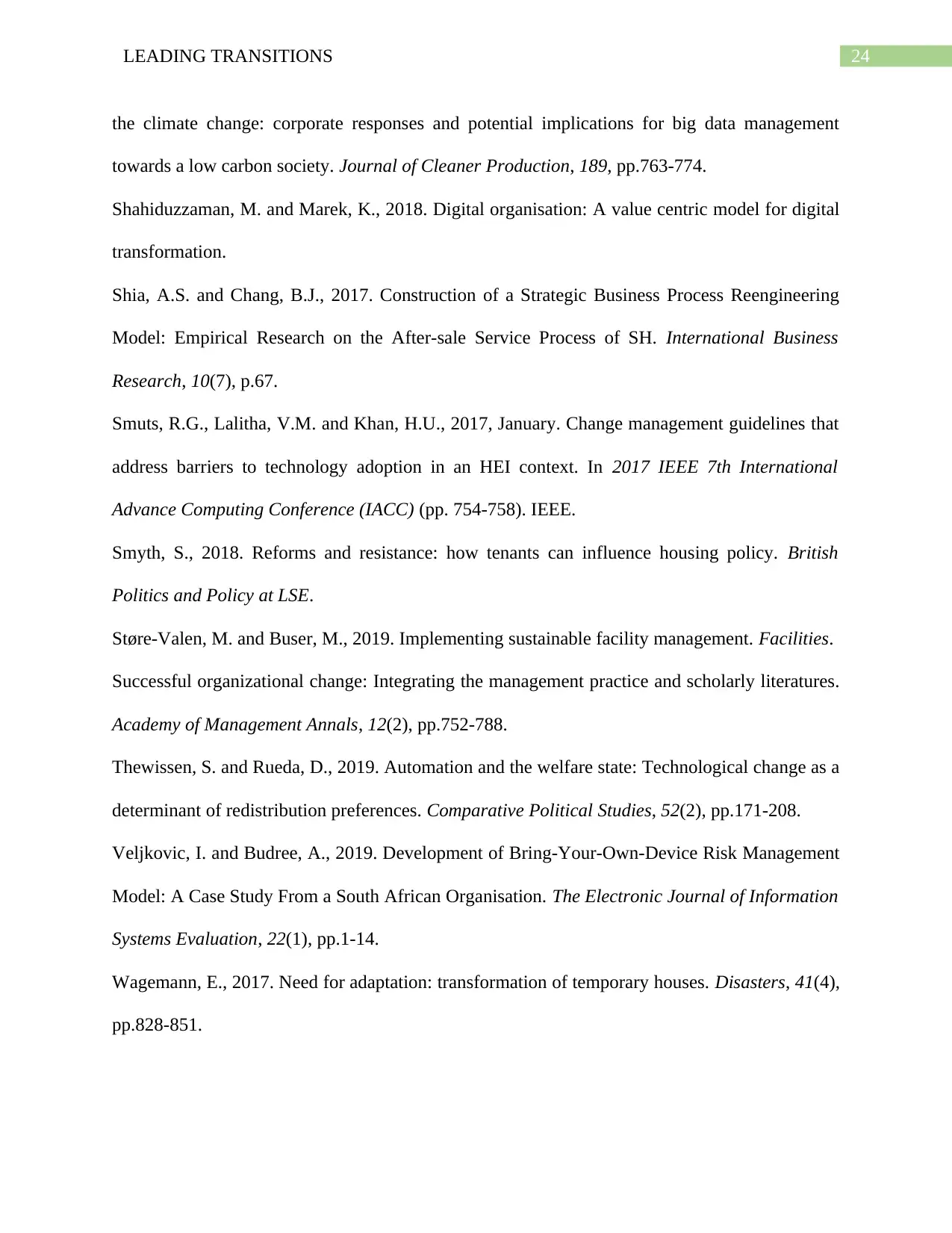
24LEADING TRANSITIONS
the climate change: corporate responses and potential implications for big data management
towards a low carbon society. Journal of Cleaner Production, 189, pp.763-774.
Shahiduzzaman, M. and Marek, K., 2018. Digital organisation: A value centric model for digital
transformation.
Shia, A.S. and Chang, B.J., 2017. Construction of a Strategic Business Process Reengineering
Model: Empirical Research on the After-sale Service Process of SH. International Business
Research, 10(7), p.67.
Smuts, R.G., Lalitha, V.M. and Khan, H.U., 2017, January. Change management guidelines that
address barriers to technology adoption in an HEI context. In 2017 IEEE 7th International
Advance Computing Conference (IACC) (pp. 754-758). IEEE.
Smyth, S., 2018. Reforms and resistance: how tenants can influence housing policy. British
Politics and Policy at LSE.
Støre-Valen, M. and Buser, M., 2019. Implementing sustainable facility management. Facilities.
Successful organizational change: Integrating the management practice and scholarly literatures.
Academy of Management Annals, 12(2), pp.752-788.
Thewissen, S. and Rueda, D., 2019. Automation and the welfare state: Technological change as a
determinant of redistribution preferences. Comparative Political Studies, 52(2), pp.171-208.
Veljkovic, I. and Budree, A., 2019. Development of Bring-Your-Own-Device Risk Management
Model: A Case Study From a South African Organisation. The Electronic Journal of Information
Systems Evaluation, 22(1), pp.1-14.
Wagemann, E., 2017. Need for adaptation: transformation of temporary houses. Disasters, 41(4),
pp.828-851.
the climate change: corporate responses and potential implications for big data management
towards a low carbon society. Journal of Cleaner Production, 189, pp.763-774.
Shahiduzzaman, M. and Marek, K., 2018. Digital organisation: A value centric model for digital
transformation.
Shia, A.S. and Chang, B.J., 2017. Construction of a Strategic Business Process Reengineering
Model: Empirical Research on the After-sale Service Process of SH. International Business
Research, 10(7), p.67.
Smuts, R.G., Lalitha, V.M. and Khan, H.U., 2017, January. Change management guidelines that
address barriers to technology adoption in an HEI context. In 2017 IEEE 7th International
Advance Computing Conference (IACC) (pp. 754-758). IEEE.
Smyth, S., 2018. Reforms and resistance: how tenants can influence housing policy. British
Politics and Policy at LSE.
Støre-Valen, M. and Buser, M., 2019. Implementing sustainable facility management. Facilities.
Successful organizational change: Integrating the management practice and scholarly literatures.
Academy of Management Annals, 12(2), pp.752-788.
Thewissen, S. and Rueda, D., 2019. Automation and the welfare state: Technological change as a
determinant of redistribution preferences. Comparative Political Studies, 52(2), pp.171-208.
Veljkovic, I. and Budree, A., 2019. Development of Bring-Your-Own-Device Risk Management
Model: A Case Study From a South African Organisation. The Electronic Journal of Information
Systems Evaluation, 22(1), pp.1-14.
Wagemann, E., 2017. Need for adaptation: transformation of temporary houses. Disasters, 41(4),
pp.828-851.
Paraphrase This Document
Need a fresh take? Get an instant paraphrase of this document with our AI Paraphraser
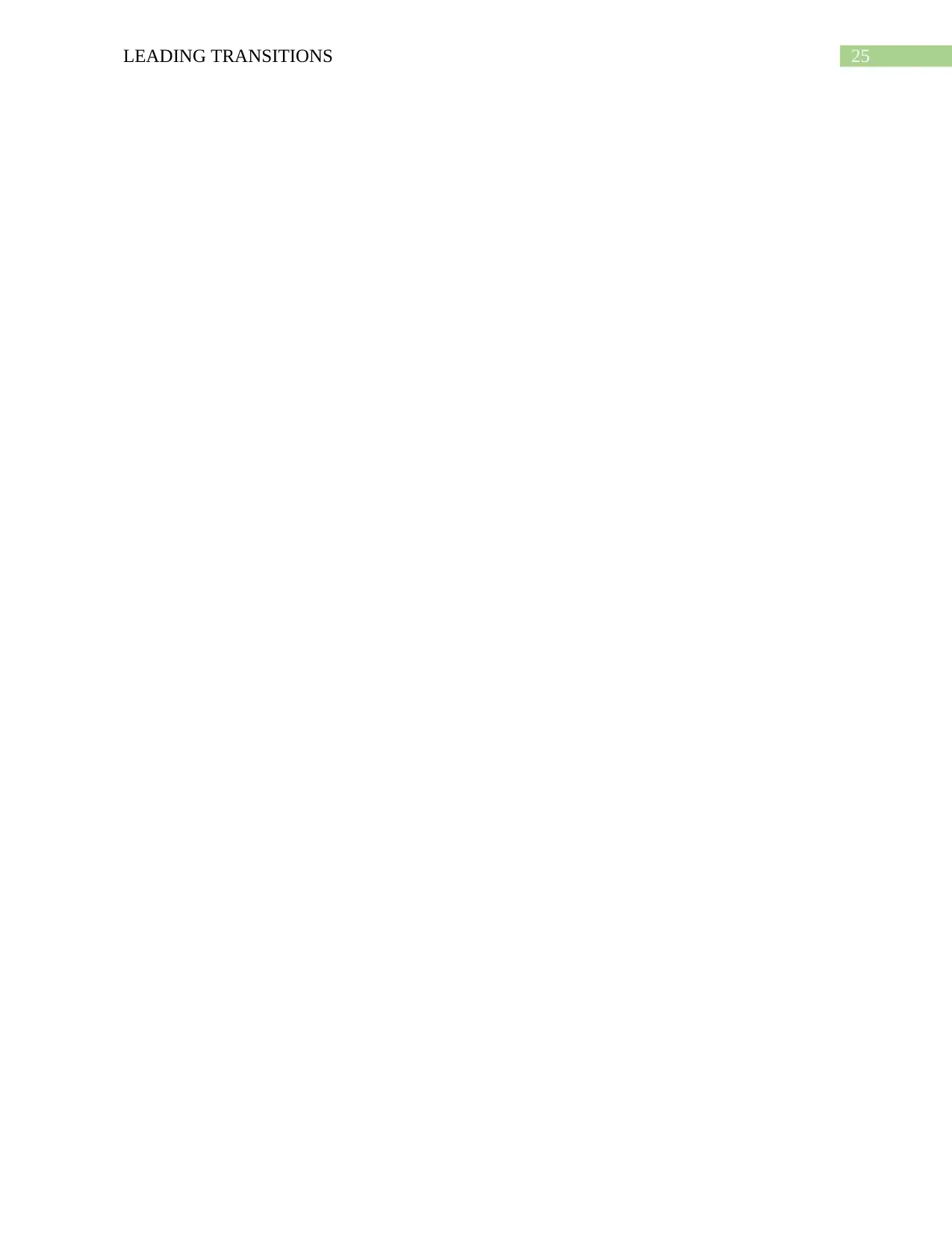
25LEADING TRANSITIONS
1 out of 26
Related Documents
Your All-in-One AI-Powered Toolkit for Academic Success.
+13062052269
info@desklib.com
Available 24*7 on WhatsApp / Email
![[object Object]](/_next/static/media/star-bottom.7253800d.svg)
Unlock your academic potential
© 2024 | Zucol Services PVT LTD | All rights reserved.





